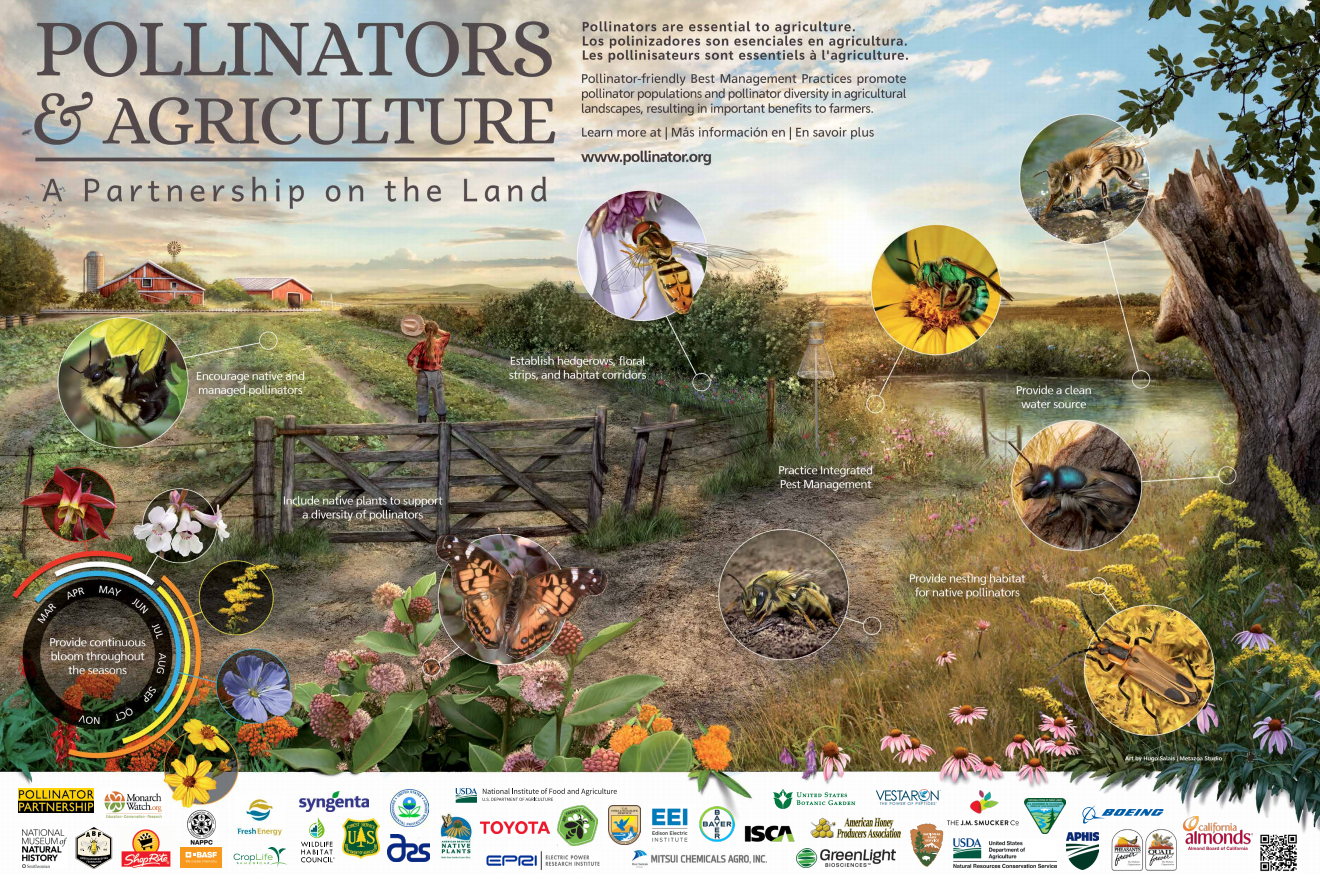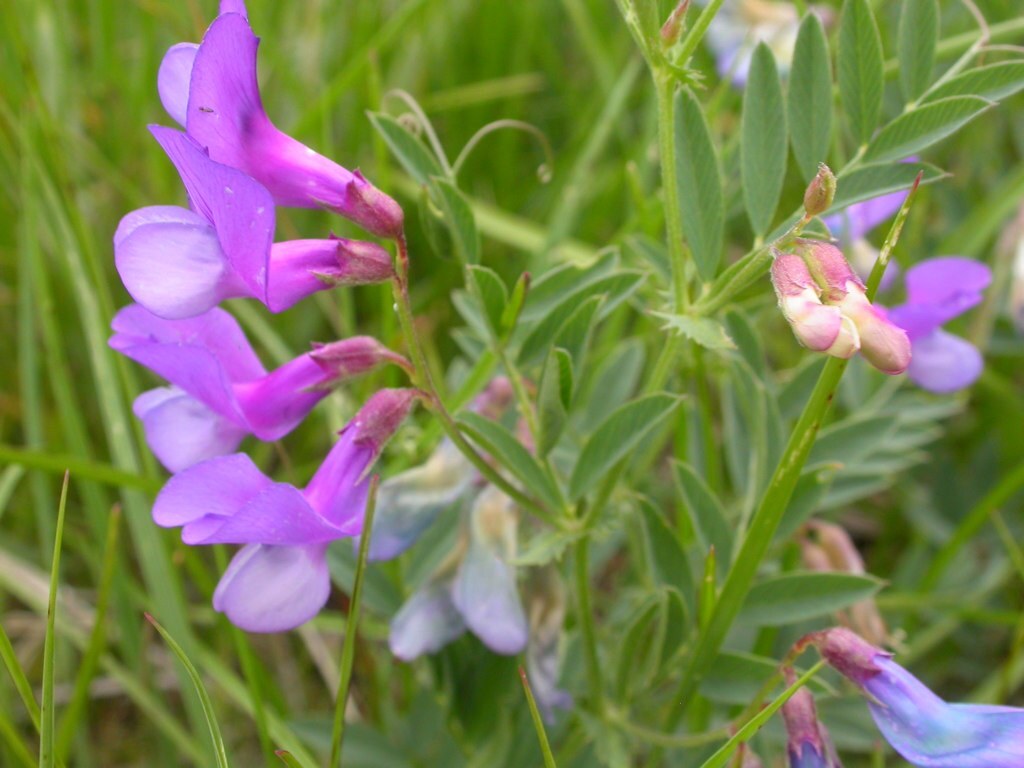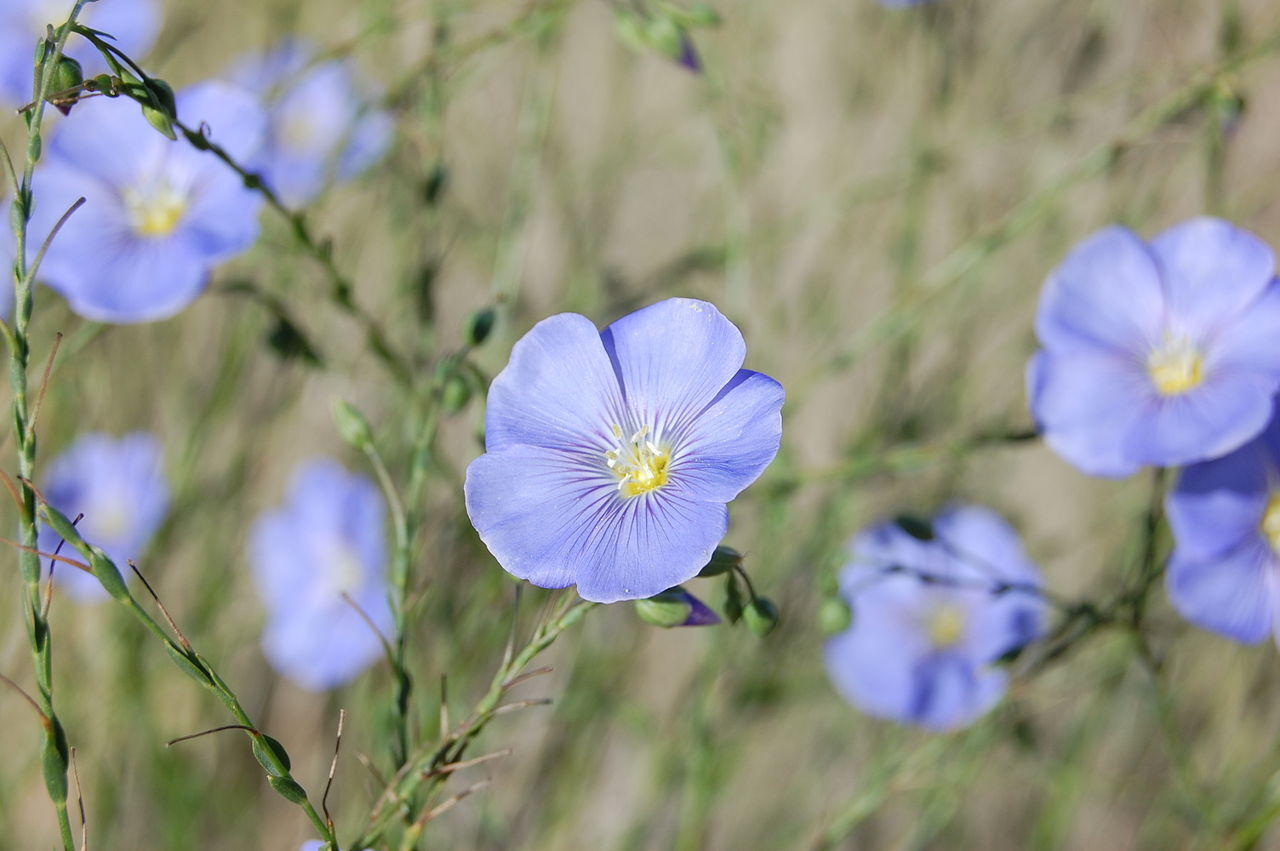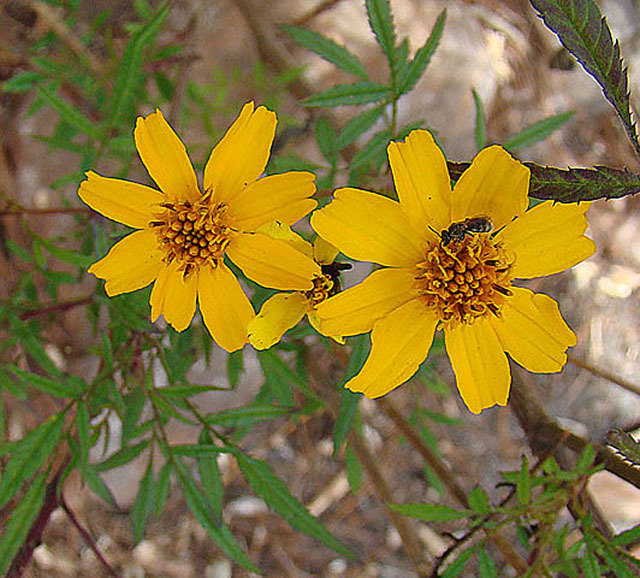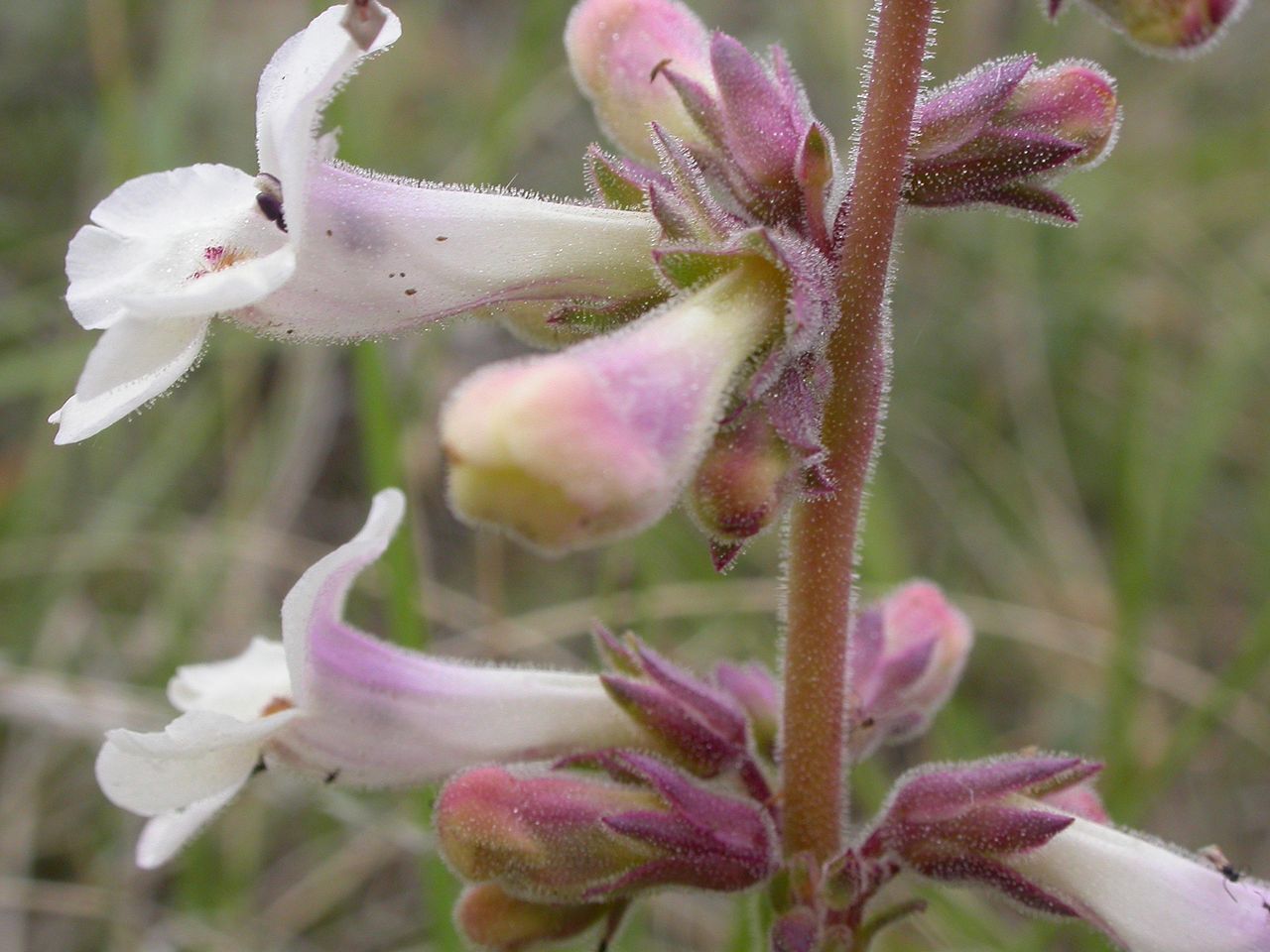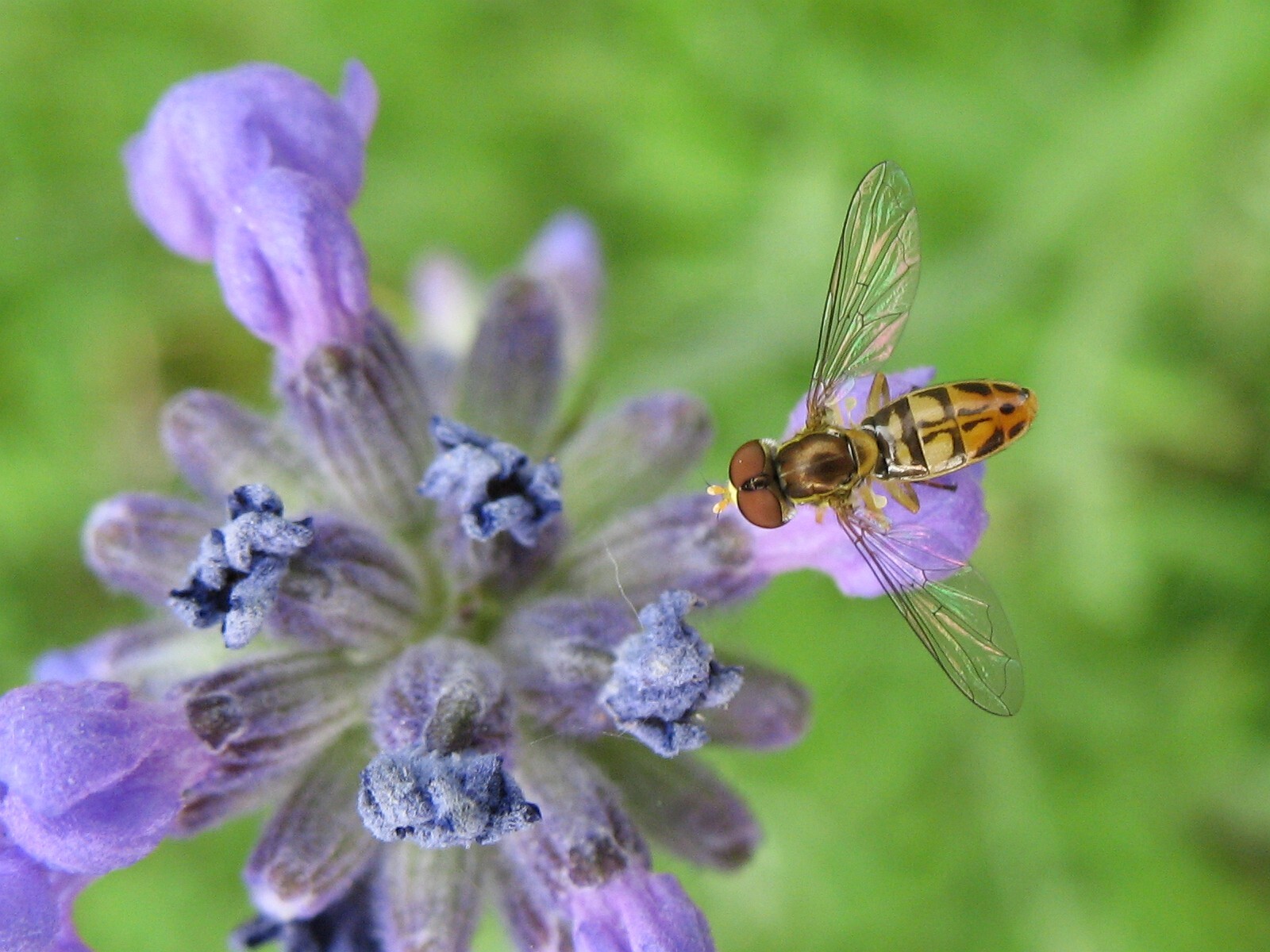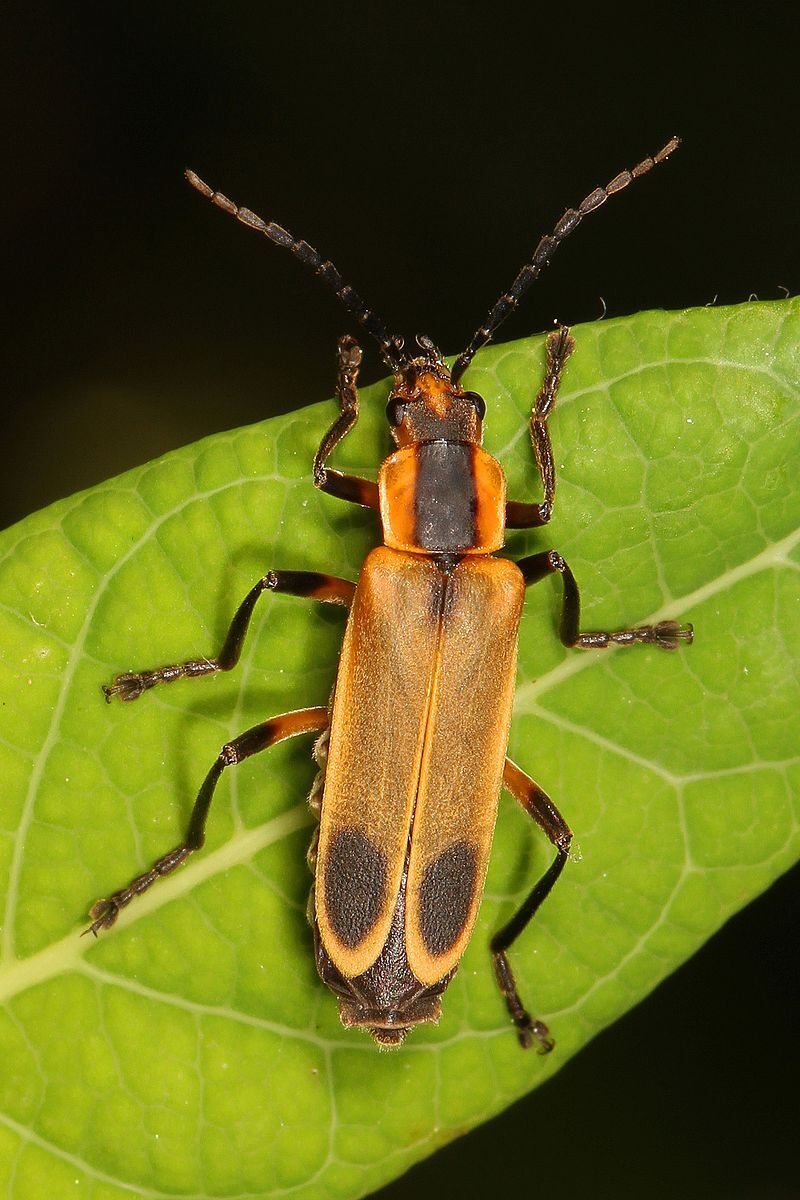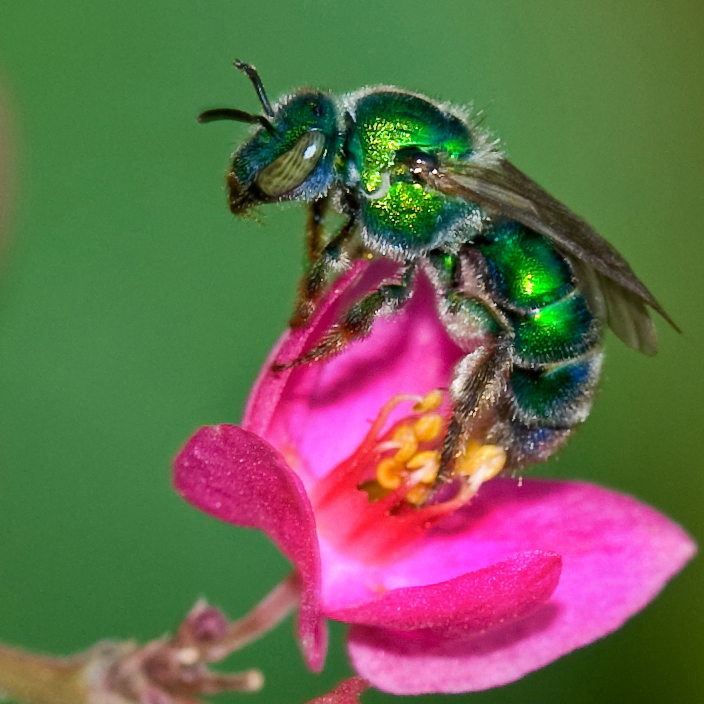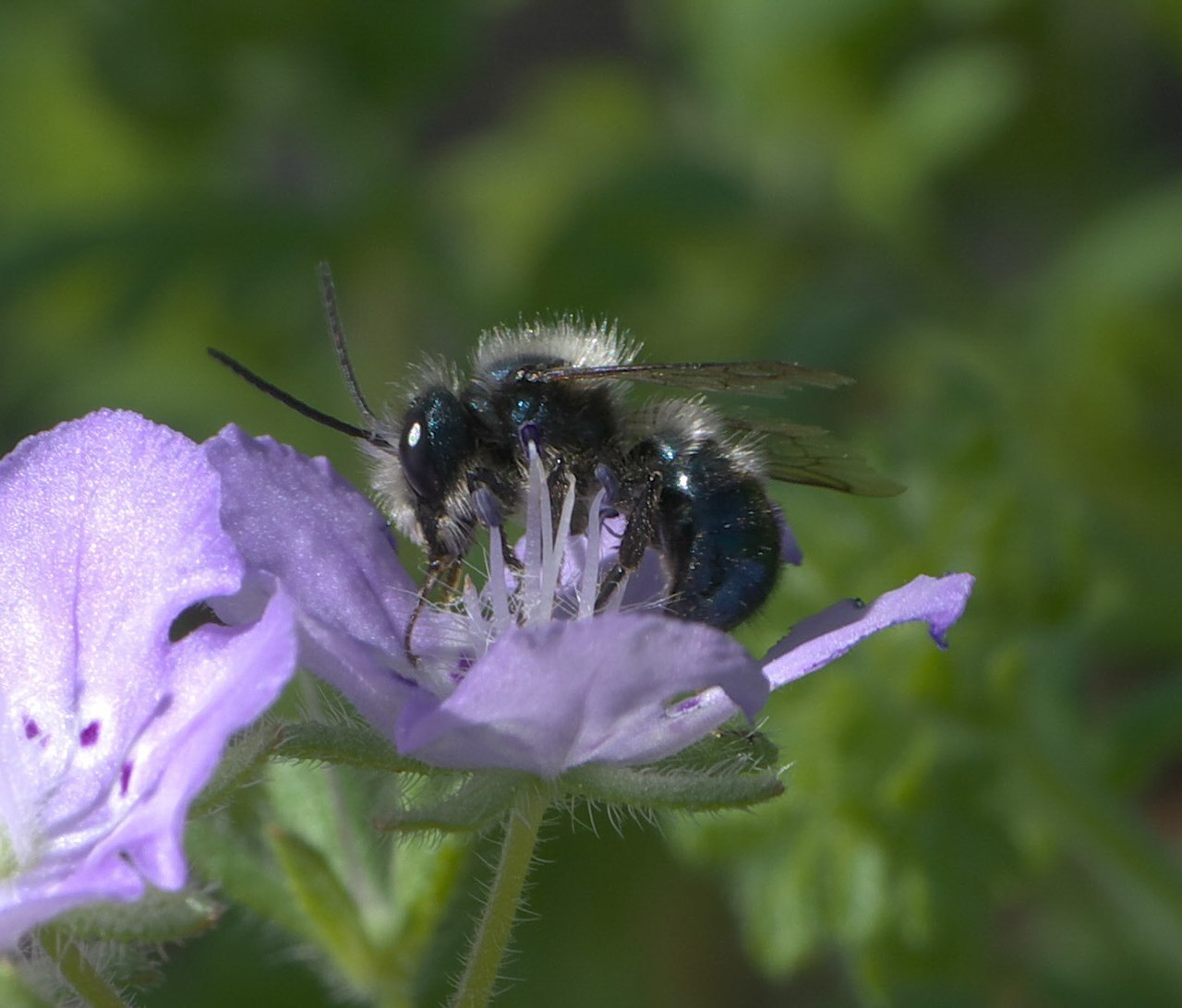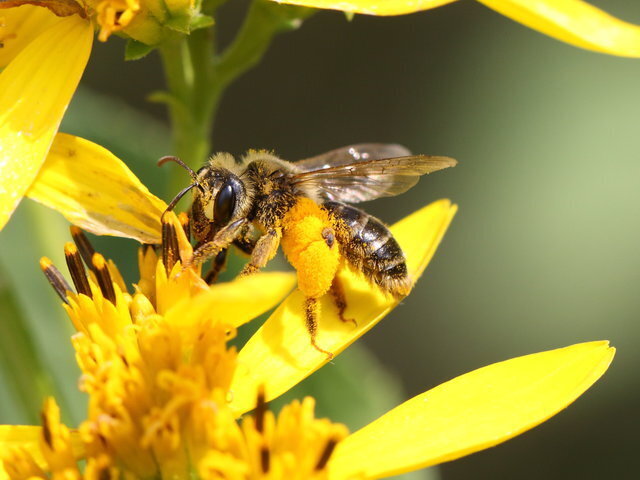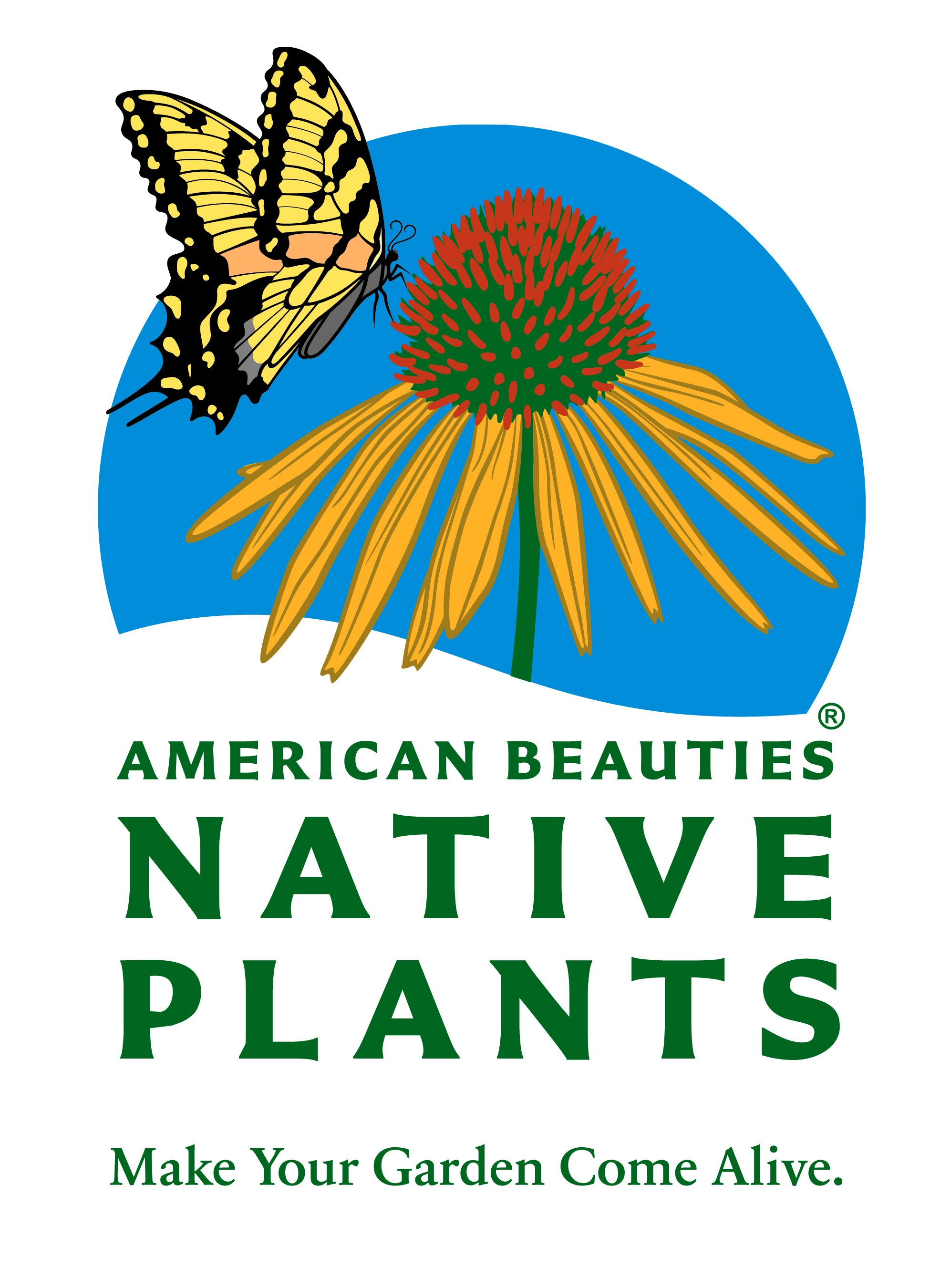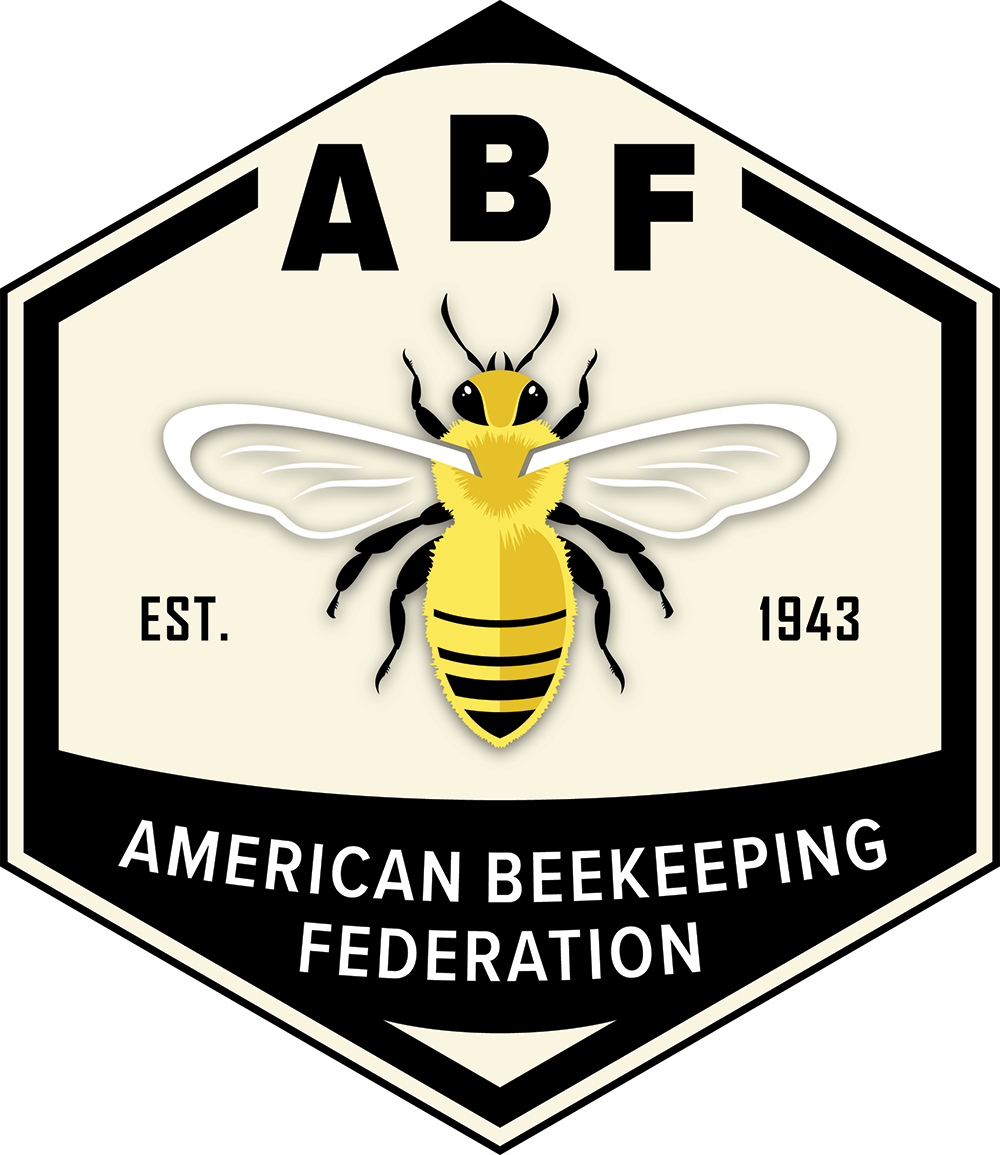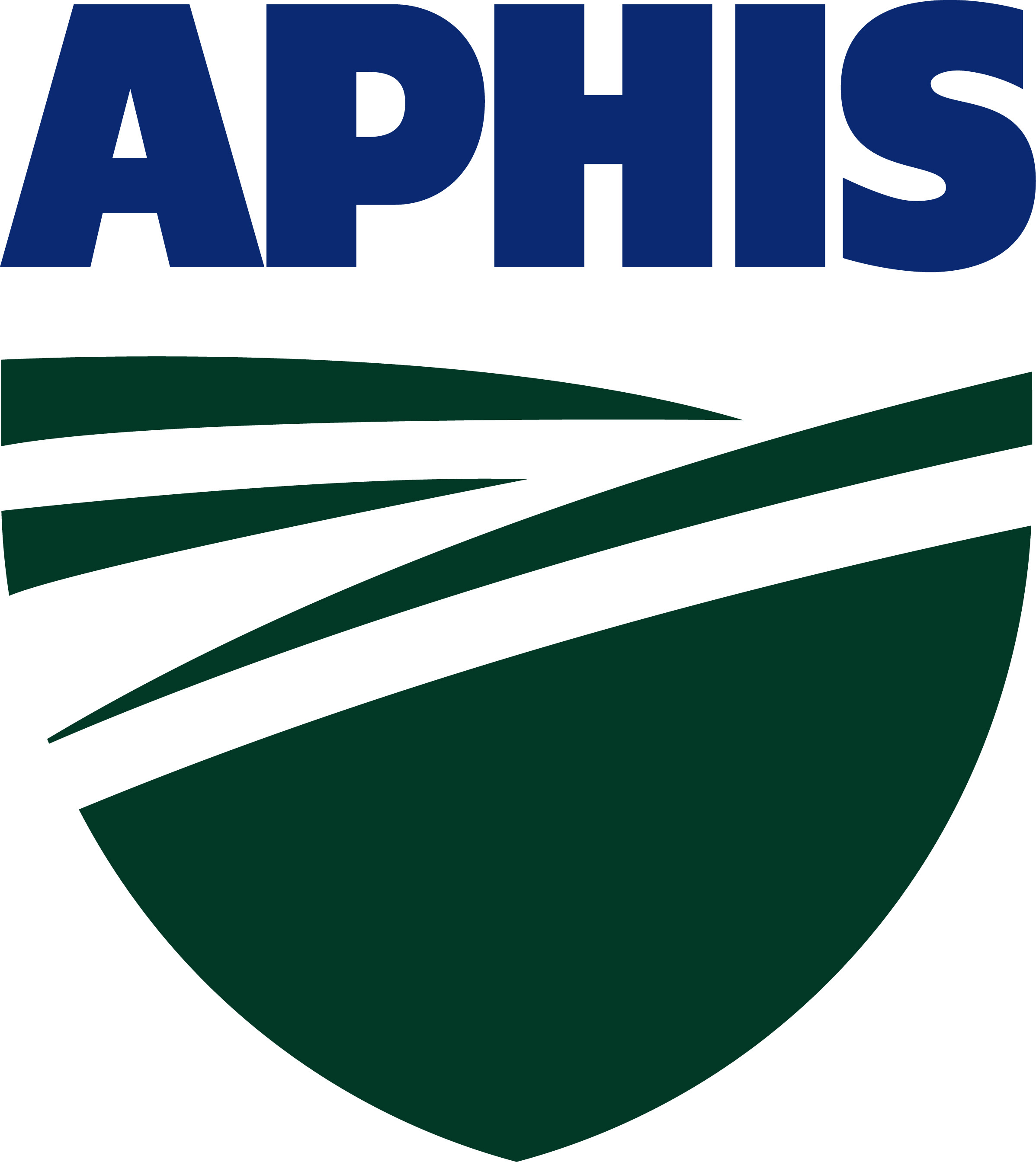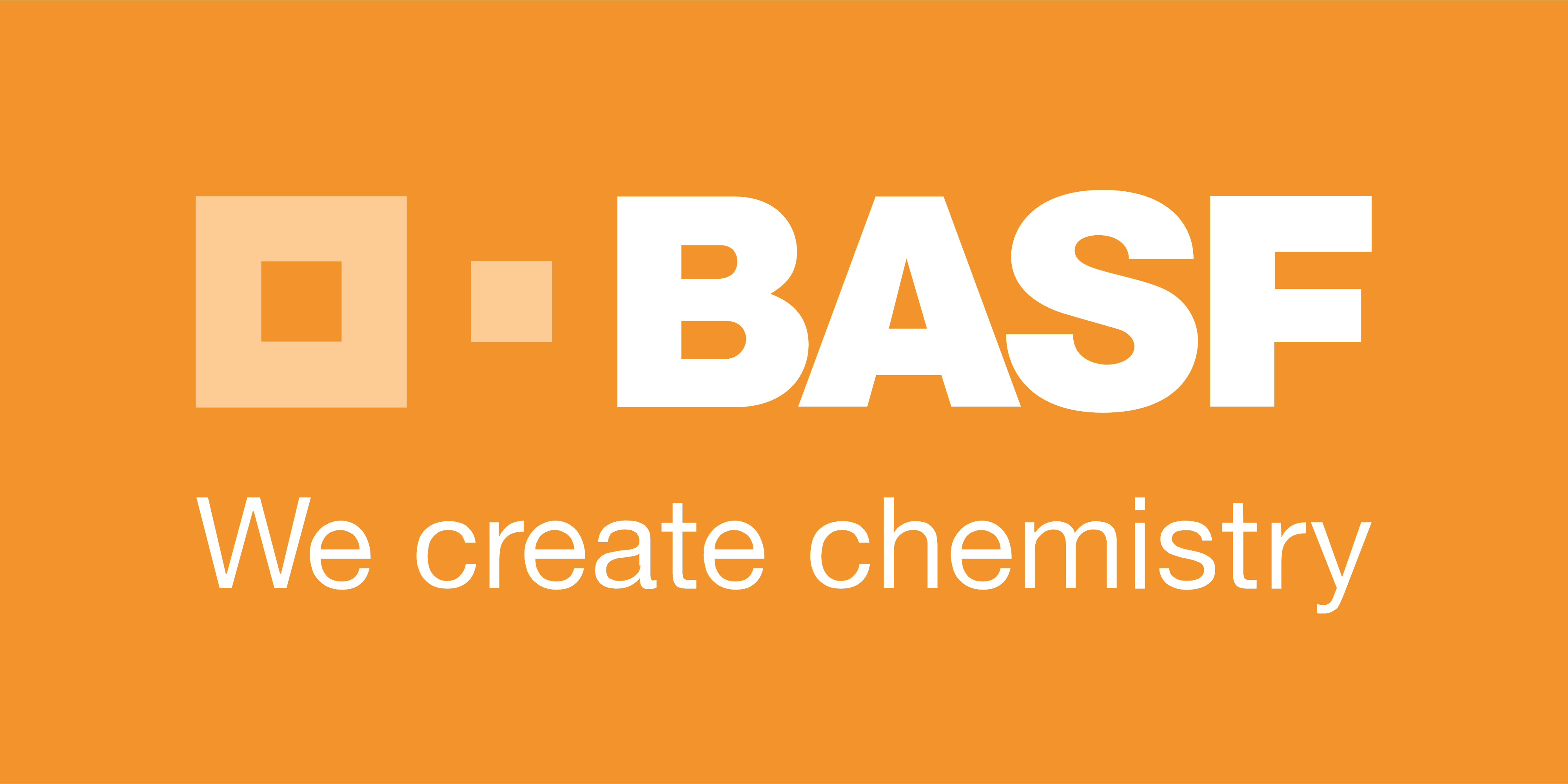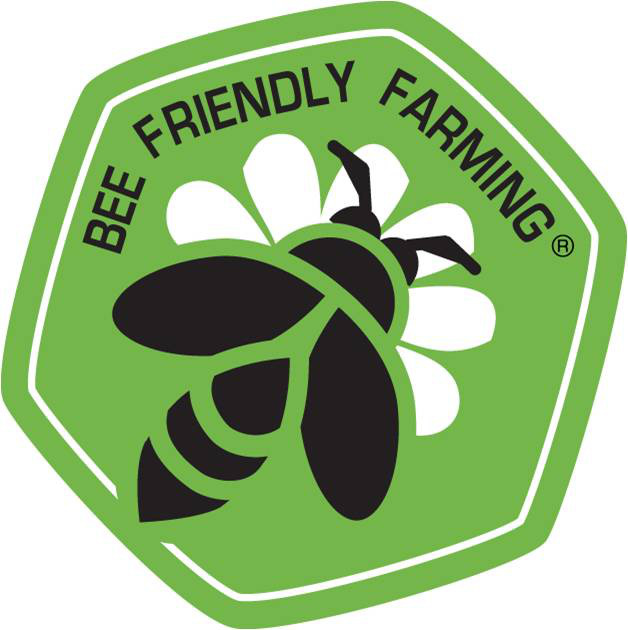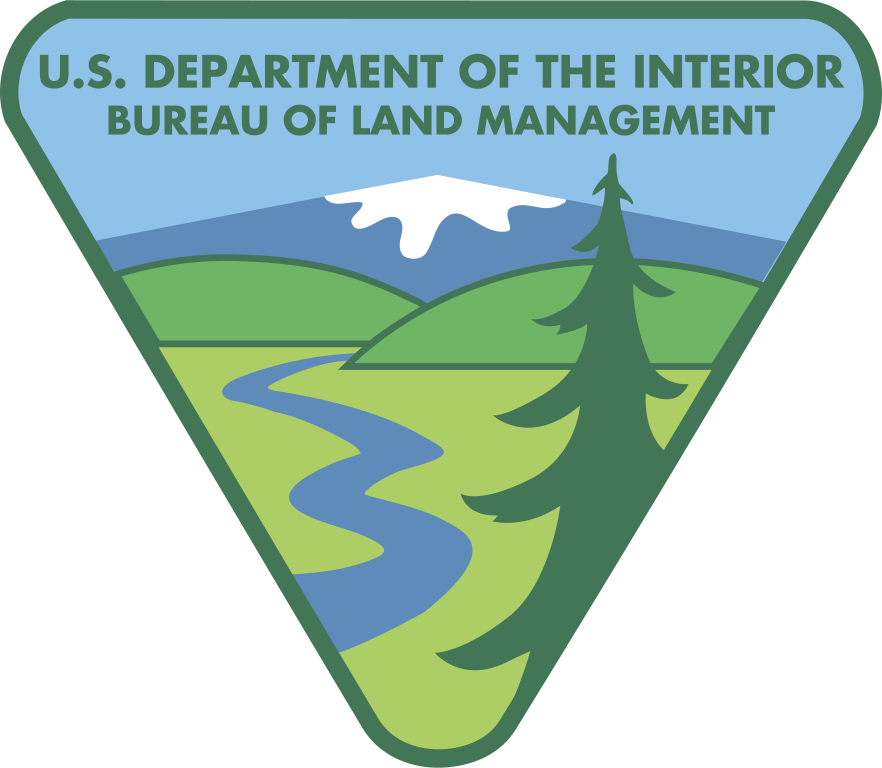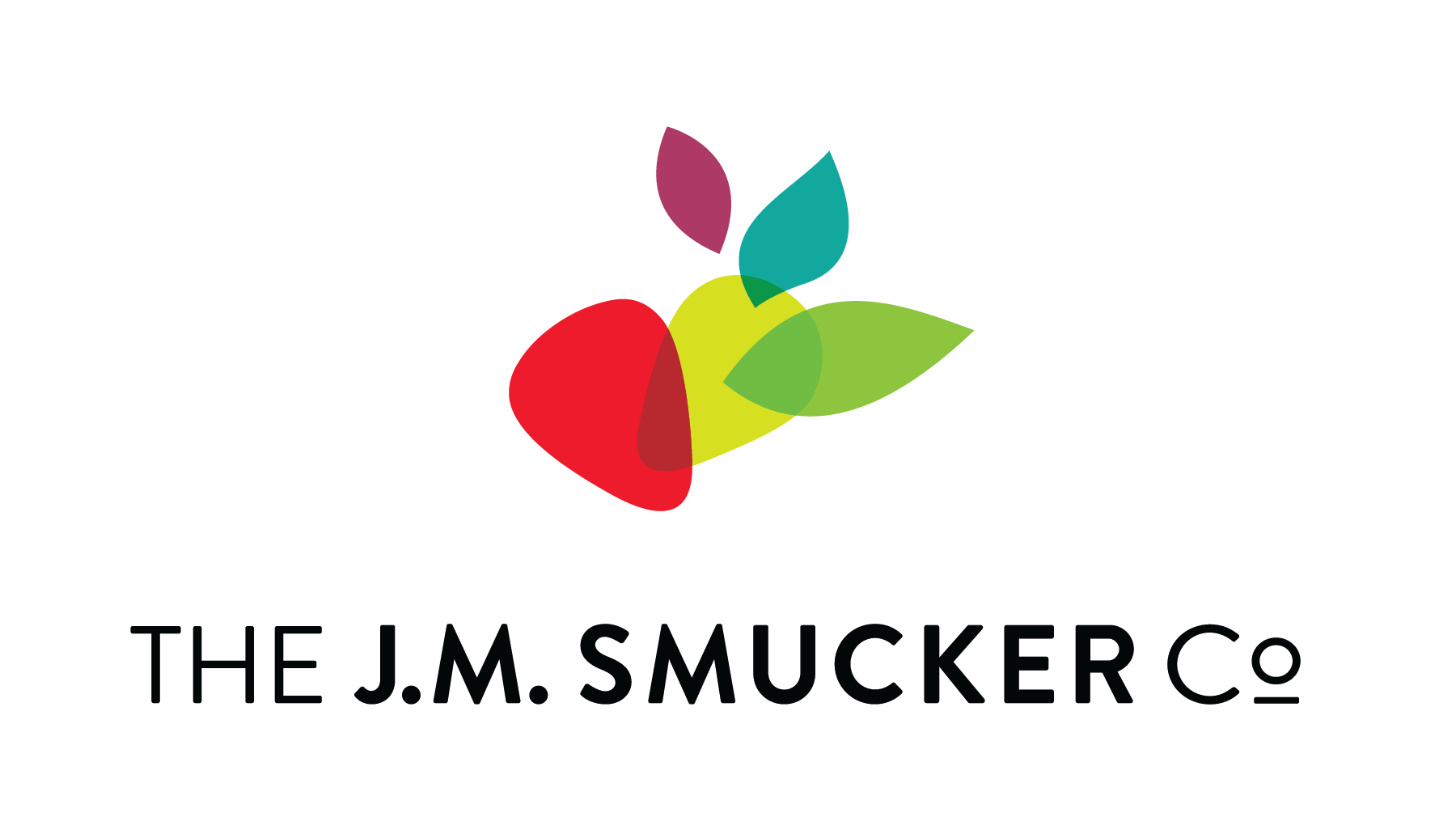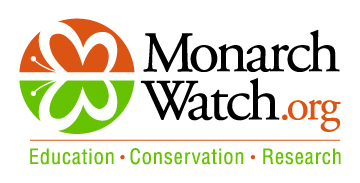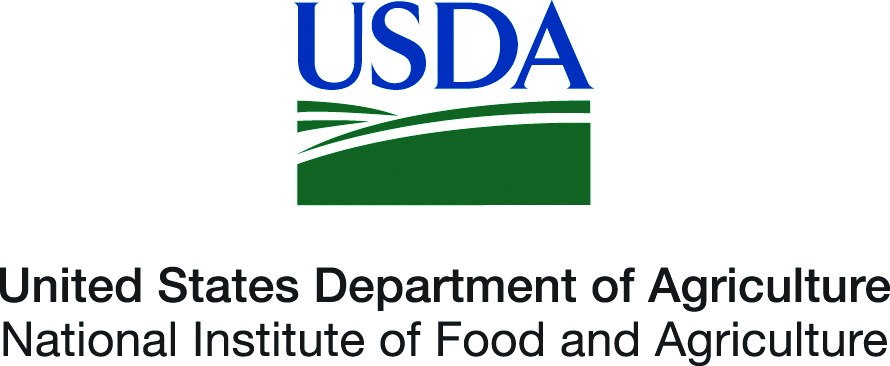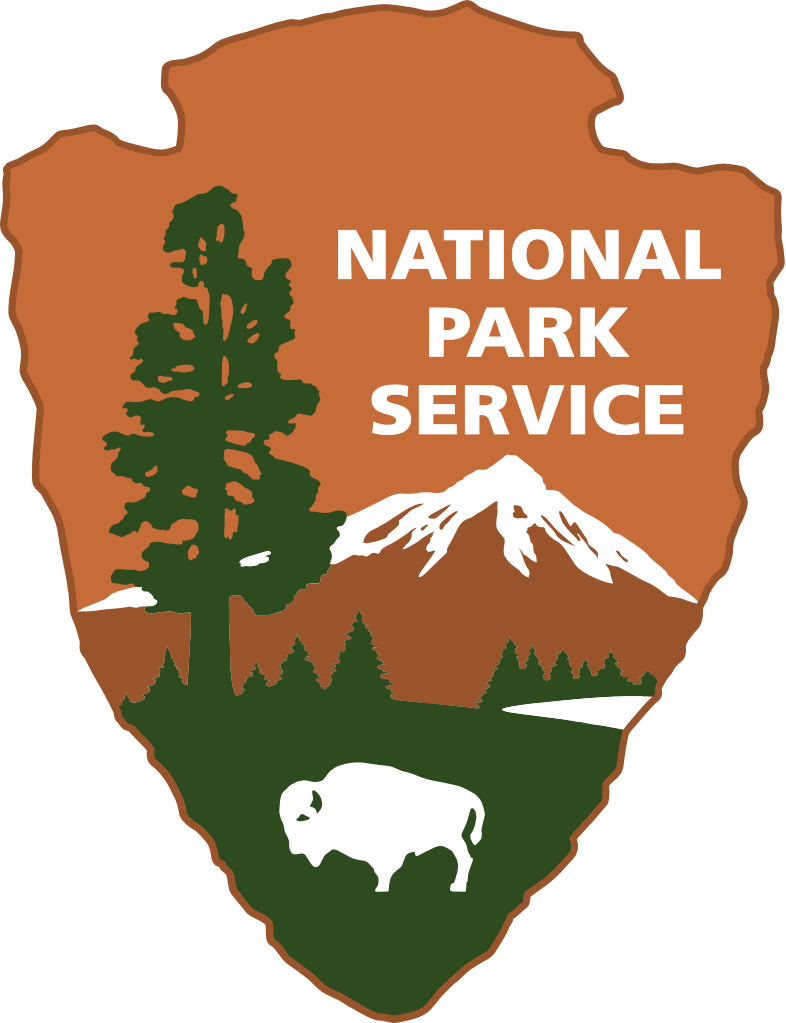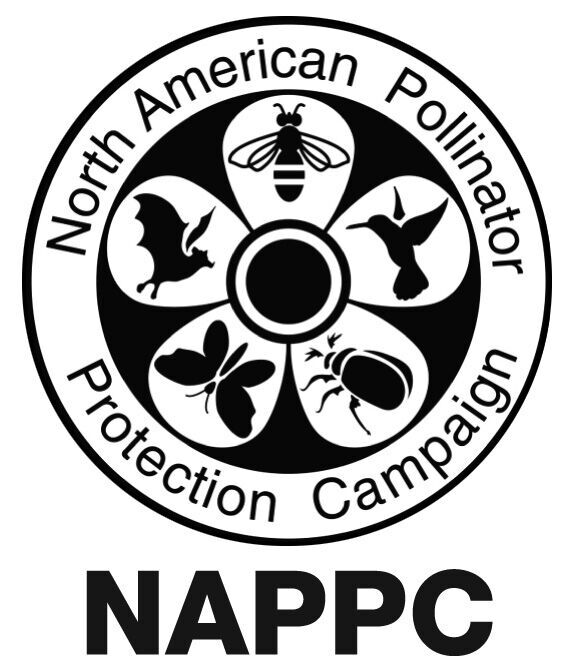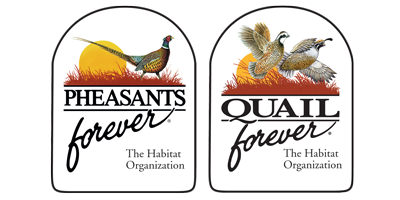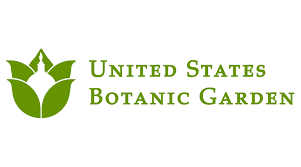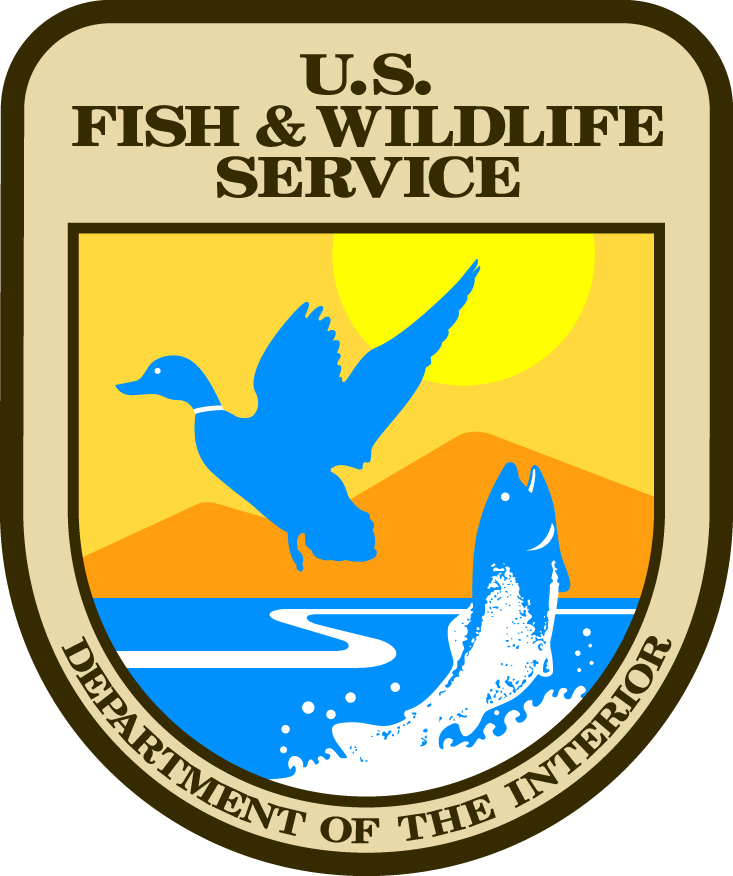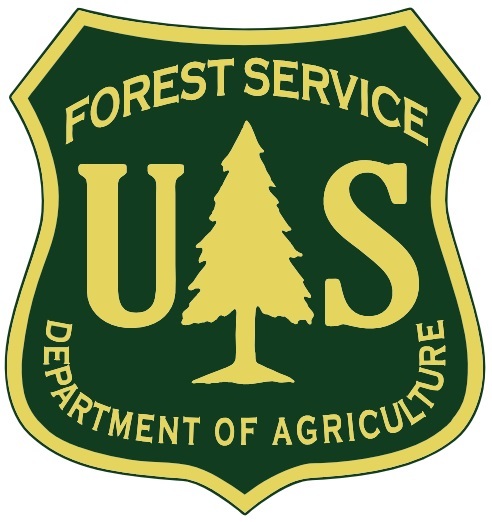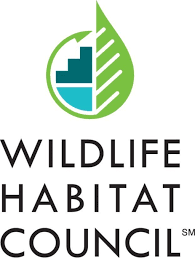Pollinators and Agriculture: A Partnership on the Land
This year's poster “Pollinators and Agriculture: A Partnership on the Land" by artist Hugo Salais is an artistic depiction of the harmony that can be achieved when agricultural landscapes embrace pollinator-friendly management practices. Order yours today!
Poster is 36" W x 24" H
Click here for a virtual tour of the poster!
(Be patient. This sometimes takes a while to load.)
Download Poster
About the Artist

Hugo Salais is a freelance scientific illustrator based in Valencia, Spain. After pursuing an academic career in life sciences, he committed to the field of scientific illustration, where he helps professionals in the scientific and cultural communities to bring subjects of science and the natural world to life in a comprehensive and eye-catching way. His work has been commissioned by leading research groups, scientific and cultural entities, published both in specialized and outreach media and showcased internationally at museums and exhibits. Working primarily in digital media, his philosophy when illustrating involves merging the best of both fields: creativity and scientific accuracy hand in hand to portray the beauty of the natural world and the principles that direct it. Currently, he combines his work with teaching of scientific illustration in digital 2D and 3D media. His portfolio can be viewed at www.metazoa.studio.
Process
After checking the theme for this year’s poster, I immediately envisioned the following concept: a familiar agricultural landscape, seemingly quiet on the surface, but teeming with life, activity and diversity when zooming in on the pollinators. This setting would be in turn ideal to show how pollinators contribute to support agricultural ecosystems and what can we do in turn to help them thrive and complete the virtuous cycle.
Once the concept and sketch were approved, it was time to get into details. One of the trickier parts of the process involved creating an accurate mental image of how agricultural landscapes in the US look like. This was made possible by a thorough research and documentation phase, which in fact supported the whole creation process. Luckily, I was assisted throughout by the great team at Pollinator Partnership, which provided key information on the fauna and flora to depict and their most relevant biological aspects (geographical and seasonal ranges, ecological relationships, conservation status or impact on agricultural activity, to name some).
Both the sketch and the final art for the 2021 Pollinators Poster were created digitally, using Adobe Photoshop. In complex pieces like this, involving landscape scenes combined with multiple text and graphical elements, composition is key to achieve an harmonious and well-balanced layout of all elements, so I like to tackle this aspect first of all, planning where to place my focal points in the image to draw the viewer’s attention properly. After figuring out the composition, I focused on developing the landscape scene, working in layers (starting from the background and moving forward) and paying a strong attention to the lighting, the atmosphere and the mood. Subsequently, it was time to focus on the foreground elements, namely the plants, blooms and pollinators, which were rendered in full detail and working alongside visual references the whole time, in order to depict them as accurately as possible. After some last-minute tweaks and adjustments, the last step involved laying out the title, text boxes and other graphical elements (frames, pointers, etc.). Finally, after many hours of work, it felt great to submit the final image ready to show and print.
Management Practices
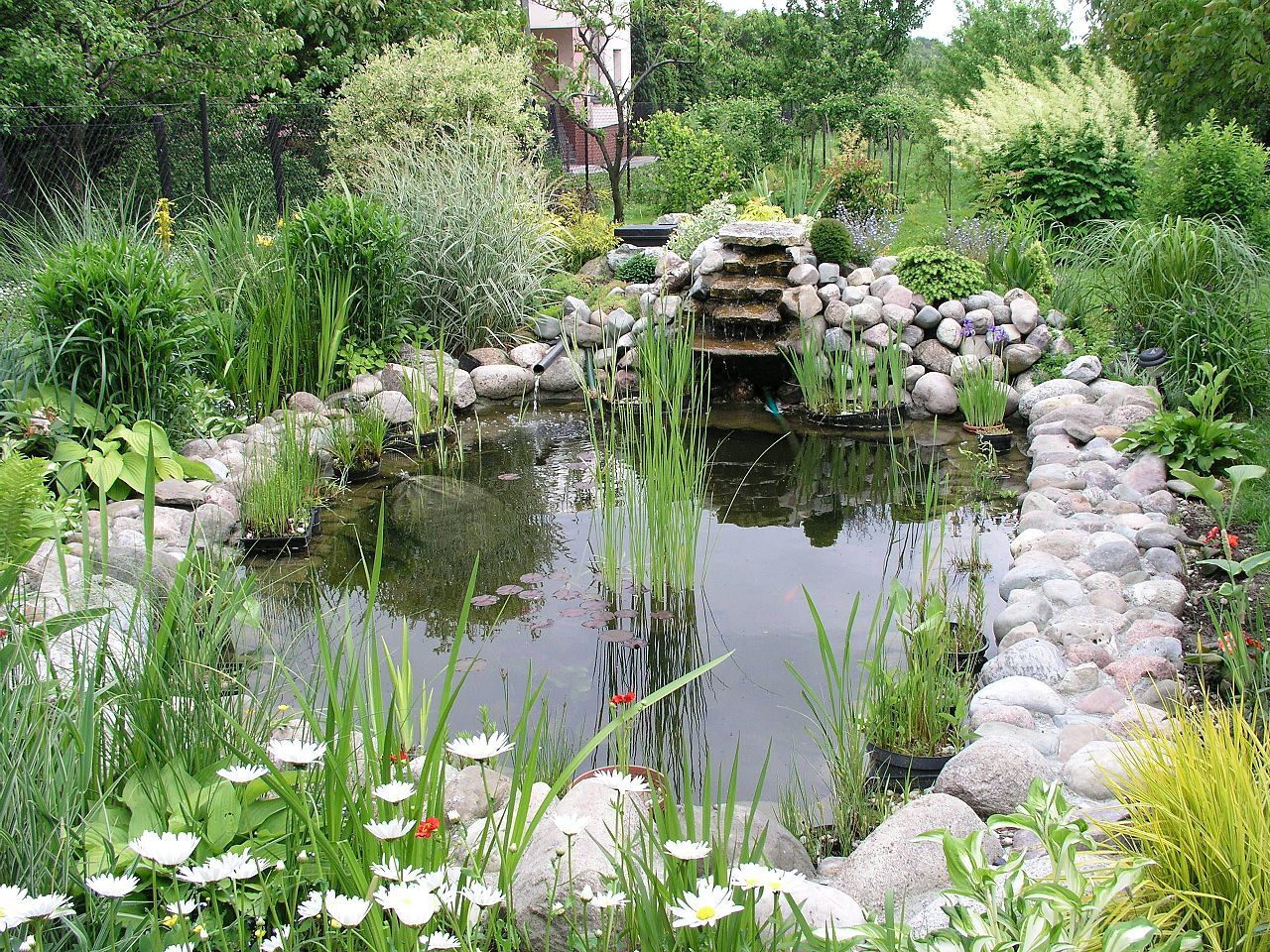
Clean Water
Clean water is perhaps the most critical natural resource to all living organisms. Pollinators need water for not only drinking, but also for reproduction. Although plant products like nectar and pollen can be an indirect source of water, they don’t contain much moisture. Pollinators actively seek water sources, and will frequently sip from both natural and manmade sources like shallow pools, ponds, streams, or mud puddles. One of the easiest actions people can take for pollinators is creating a clean water source. Clean water means water that is free of contaminants (like heavy metals), inorganic and organic solids, and any harmful bacteria.
Some ways to create a clean water source for pollinators are:
- Placing a container of water out in the open*
- Adding a bird bath (the bird’s will share!)
- Installing a water garden
- Hanging a dripping bottle
Remember, pollinators can’t swim! Good water sources are often shallow and/or include varying sizes of rocks, corks, or pebbles so that the insects may stand where it’s dry and drink from the source. *A container of water can range in size from a small bowl to a large pool. Whatever the container size, ensure that the water can be kept clean by changing it frequently (2-3 times/week), installing a filtration system, etc. Before a clean water source is installed, it’s best to survey the landscape to ensure that a clean water source doesn’t already exist. This may take the form of a natural pond, stream, or pool.
https://www.pollinator.org/bff/bff-us/farming-resources
https://www.sare.org/wp-content/uploads/Managing-Alternative-Pollinators.pdf
https://ento.psu.edu/research/centers/pollinators/public-outreach/cert/cert-steps-step2
http://www.beethechange.life/the-buzz/2017/5/5/create-your-own-water-source-for-pollinators
https://ucanr.edu/blogs/blogcore/postdetail.cfm?postnum=26345
http://seeds.ca/pollinator/bestpractices/protection.html
Photo by Sarah Olson-Rosenbaum
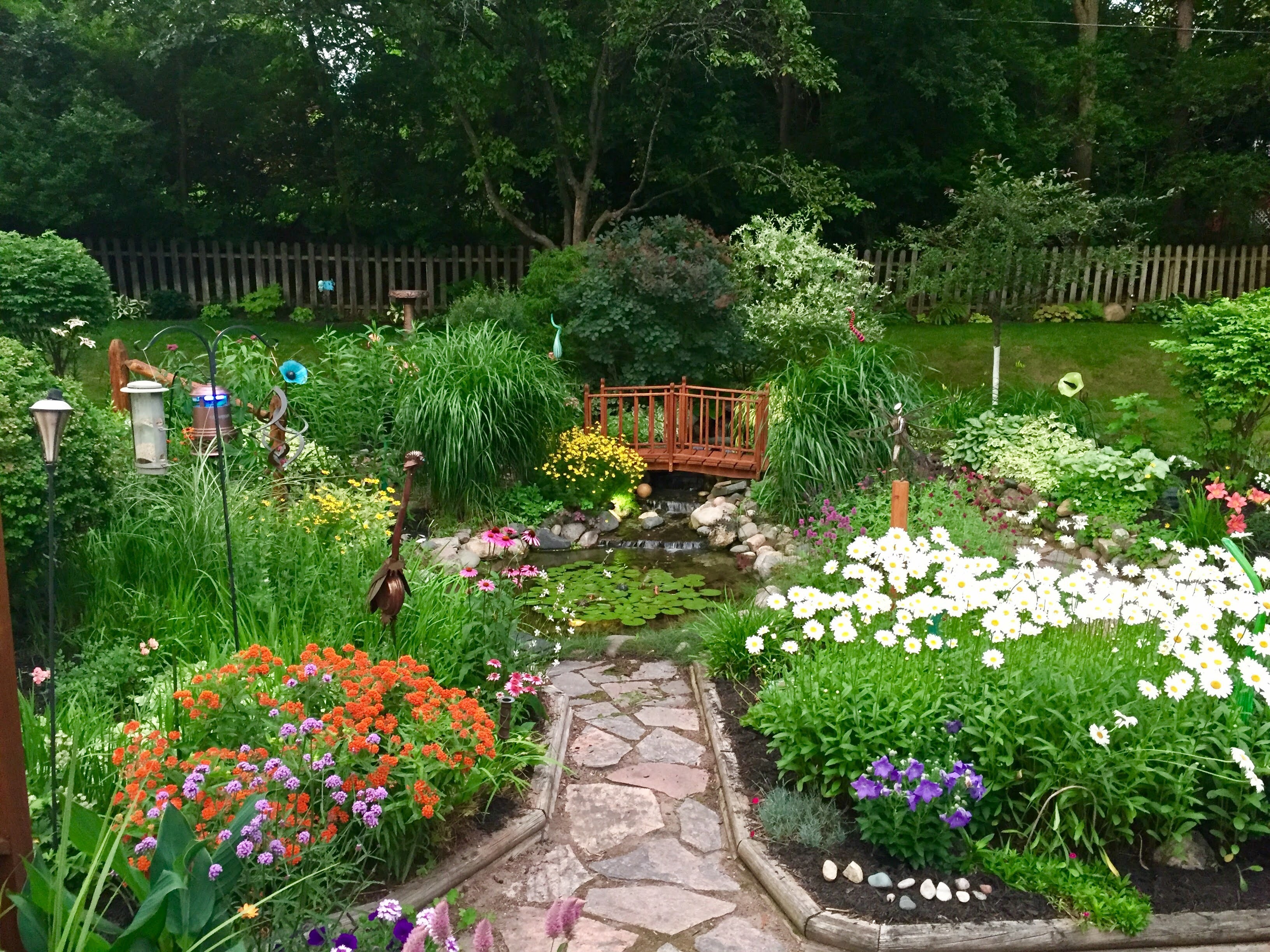
Continuous Bloom
A crucial basic need for all living things is food! Just as humans need essential nutrients, so do pollinators and this is provided by the nectar and pollen of flowering plants. Because flowering resources are the main source of food for pollinators, it is critical that there is year-round availability to pollinators. Planting a continuous bloom throughout the growing season (Spring, Summer, and Fall), especially in early spring and late autumn in temperate regions, can ensure that pollinators always have a proper source of nectar and pollen.
Incorporating a variety of native flowers with different, but complementary blooming periods takes proper planning and research. Some examples of plants that provide floral resources are goldenrod, bee balm, asters, milkweed, and many many more. can ensure the landscape is properly equipped to support pollinators. By looking at a species bloom period, you can determine a peak flowering season. Choosing several species that bloom in each season will ensure that your pollinator habitat is equipped to support visiting insects. Don’t forget, night blooming flowers can help support the pollinating bats and moths!
Lastly, when researching which floral resources to incorporate into your landscape, it is important to ensure that plants are native to your ecoregion. Check out the Pollinator Partnership Ecoregional Planting Guides to find plant species native to your area!
https://www.pollinator.org/guides
https://www.pollinator.org/guides-canada
https://www.pollinator.org/gardencards
https://www.sare.org/wp-content/uploads/Managing-Alternative-Pollinators.pdf
https://www.fws.gov/pollinators/pdfs/USAF_Pollinator_Ref_Guide_App_B.pdf
Photo by Amber Barnes
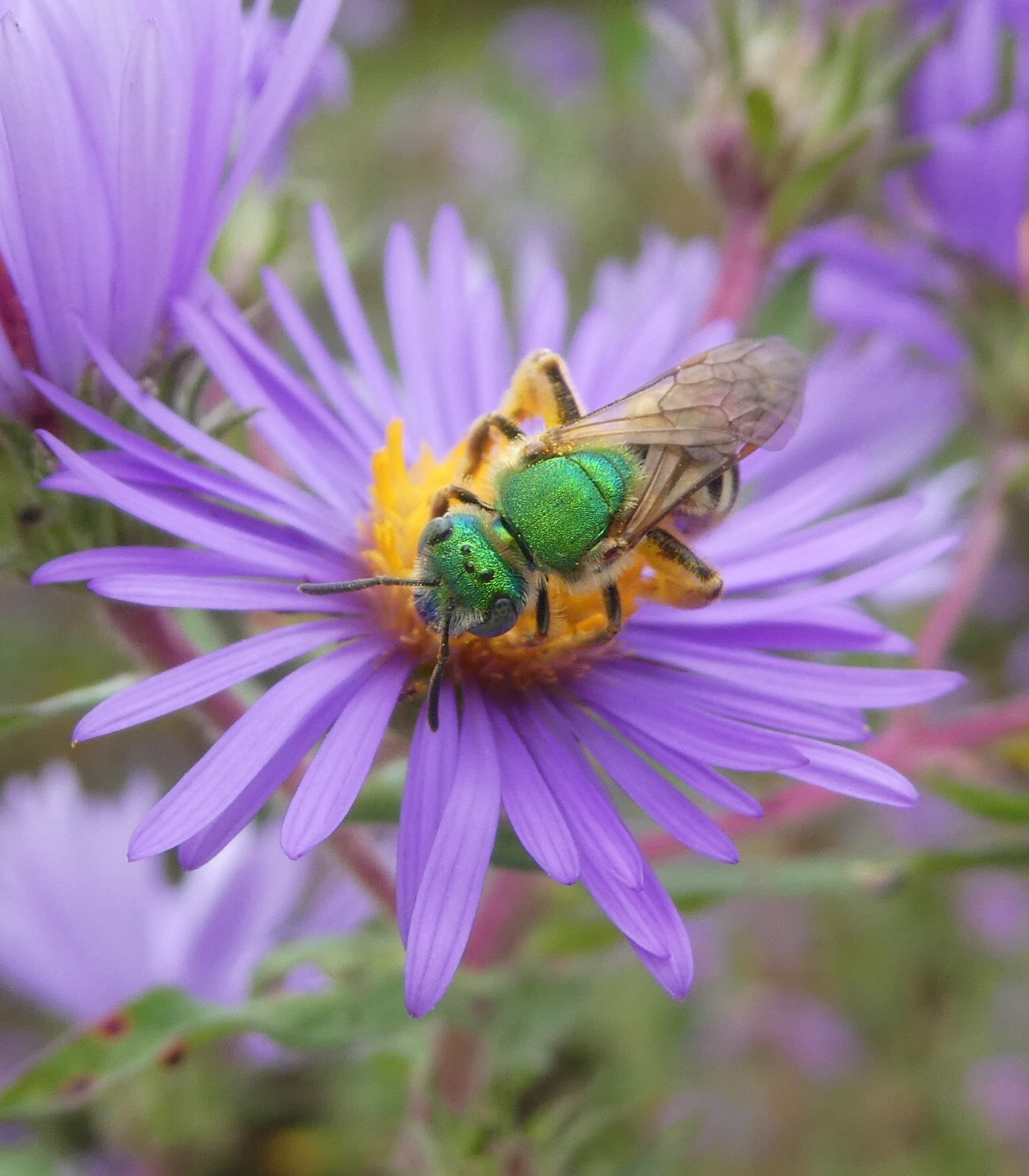
Encourage Native and Managed Pollinators
Native pollinators, like native plants, are pollinators that have developed in a particular ecosystem or region over hundreds or thousands of years, and therefore, have evolved to feed off of specific plants within a specific environment. Managed pollinators are pollinators (typically bees) that are being used by humans for crop pollination to increase the yield in an agricultural setting. Perhaps the most commonly known managed pollinators are honey bees (Apis mellifera) which are native to Europe, western Asia, and Africa, but have been introduced globally. Bumble bees, alfalfa leafcutter bees, and mason bees are also frequently managed as crop pollinators, and specialize based on the crop (Alfalfa leafcutter bees specialize in alfalfa, hence the name). Both native and managed pollinators play a critical role in both the agricultural system, and greater ecosystems.
Some ways to encourage native and managed pollinators are:
- Ensure there are sufficient floral resources and habitat for foraging pollinators and consider whether those flowering plants are of high value to the surrounding pollinators. Ask yourself:
- Is the shape of the flower accessible to pollinators (short-tongued vs long-tongued bees, beetles, hummingbirds, etc.)
- Is there continuous bloom from early Spring through the late Fall? (include at least three flowering species per season)
- Some pollinators need proper environments in order to reproduce. For some butterfly and moth species, appropriate larval and host plants should be available. For native bees, ground nesting areas or bee blocks should be available. See Resources for more information.
- Pollinators need homes too! Ensure that shelter is available in the form of windbreaks, proper plantings, nesting blocks, bare spots, hollow twigs and stems, tall grasses, and fallen logs.
- Protect pollinators from pesticide exposure (see Integrated Pest Management for more information).
- Minimize mowing of marginal lands to preserve floral resources.
- Provide a source of clean water!
https://www.pollinator.org/guides
https://www.pollinator.org/pollinator.org/assets/generalFiles/PollinatorFriendlyPractices.pdf
https://pollinatorpartnership.ca/assets/generalFiles/LandManagerGuide.Ontario.Farms.FINAL.PDF
https://www.sare.org/wp-content/uploads/Managing-Alternative-Pollinators.pdf
https://pollinator.cals.cornell.edu/pollinator-conservation/managed-bees-crop-pollinators/
https://www.pollinator.org/bff/bff-us/farming-resources
Photo by Shannon Westlake
Establish Hedgerows, Floral Strips, and Habitat Corridors
Establishing habitat features like hedgerows, floral strips, and habitat corridors is a great way to support pollinators by providing a variety of options for nectar, pollen, food, and shelter. Undisturbed areas like these can serve as nesting sites for many native pollinators, since much of the surrounding land may be heavily trafficked. In agricultural settings, hedgerows can provide alternative sources of nectar and pollen for native bees when there are no crops in bloom as well as cover for overwintering pollinators. In addition to benefits for pollinators, these features can also provide numerous additional benefits like water retention and improved soil quality.
When seeking to establish permanent habitat, it’s important to observe what already exists on the land before putting in the effort to create new features. If native plant material already exists, keep it! When looking for new plant material to incorporate into your hedgerows, floral strip, or habitat corridors, consult the Pollinator Partnership Ecoregional Planting Guides to inform your decisions.
Additional Tips:
- Choose plants that are locally adapted and native to the ecoregion.
- Include at least three flowering species per season (Spring, Summer, Fall) for continuous blooming of floral resources.
- Include some small bunch grasses in addition to flowering plants to serve as nesting sites for some pollinators, and to help buffer against invasives.
- Prepare your site properly for the integration of pollinator habitat (very important!)
https://www.xerces.org/publications/guidelines/farming-for-bees
https://pollinatorpartnership.ca/assets/generalFiles/LandManagerGuide.Ontario.Farms.FINAL.PDF
https://www.pollinator.org/guides
https://www.pollinator.org/guides-canada
https://www.pollinator.org/gardencards

Integrated Pest Management
Integrated pest management (IPM) is an important component of pollinator health and ecosystem sustainability in agriculture. IPM focuses on minimizing the impacts of pesticides on pollinators and their ecosystems, as well as on human health and well-being. In IPM, chemical inputs are only used as needed according to field monitoring and established guidelines, and they are applied in such a way that risk to nontarget organisms is mitigated.
The main principles of IPM are:
- Pest monitoring and identification
- Decision making based on monitoring and thresholds
- A multi-faceted approach that combines chemical, physical, biological, and cultural control methods
- Prevention of infestations
- Evaluation and improvement of management strategies
Proper identification and monitoring of pests is vital in understanding the specific situation and potential mitigation with any possible pest infestations. Keep track of how monitoring occurs, by whom, where the information for identification is coming from (extension guidelines, etc.), and how records are stored.
Management decisions should be based on monitoring and assessing if threshold levels are met. Making science-based decisions in developing management plans ensures that growers are applying management strategies at the proper time and avoiding any unnecessary applications, reducing pesticide exposure for pollinators.
IPM benefits from a combination of management approaches that can use different modes of action and strategies, taking advantage of physiological, ecological, and behavioral characteristics of the target pests. These non-pesticide approaches reduce potentially toxic exposure to pollinators.
https://sarep.ucdavis.edu/sustainable-ag/ipm
https://www.pollinator.org/pollinator.org/assets/globals/BFF_IPM_Final.pdf
https://www.pollinator.org/learning-center/pesticides#farms
https://www.pollinator.org/pesticide-education
Photo by Amber Barnes
Native Plants
A native plant is a plant that has developed in a particular ecosystem or region over hundreds or thousands of years, and therefore, has adapted to a local growing season, climate, and soil type. Pollinators too, have developed over the years and have evolved alongside native plants. Many pollinators feed on specific plant types, whether that be as specific as a species, or as broad as a certain flower shape. For example, hummingbirds have evolved to sip nectar from long and tubular honeysuckle flowers, demonstrated by their needle-like beaks. In fact, some pollinators can only repopulate with certain native plants. The larvae of butterflies and moths can often only thrive if the eggs hatch on a specific species, at which point the larvae feed on the floral resource before transforming into an adult! When considering pollinator wellbeing in a landscape, it is important to be strategic in exactly what is being planted, according to the ecoregion!
To find plants native to an ecoregion, check out the Pollinator Partnership Ecoregional Planting Guides in the Resources section. Some things to keep in mind when establishing native plants on a landscape are:
- Consider the source of the plants. Getting seed and plant materials from local and native nurseries is the way to go! To find a native plant nursery, go to http://www.plantnative.org/
- Environmental factors like light and water requirements, and soil type can play large roles in whether a plant will prosper or not!
- Different plants will attract different pollinators, so consider the type of pollinator you want to attract, and choose plants accordingly.
https://www.pollinator.org/guides
https://www.pollinator.org/guides-canada
https://www.pollinator.org/gardencards
https://www.fs.usda.gov/wildfl...
https://www.xerces.org/publications/guidelines/farming-for-bees
Photo by Amber Barnes
Woody-Nesting Habitat
Some native bees nest in narrow tunnels in wood. In fact, about 1,200 bee species native to the United States are wood-nesting. In some plants, like box elder or elderberry, bees prefer to tunnel in the soft centers of twigs, either inhabiting old beetle larvae tunnels or excavating them themselves. Carpenter bees, for example, are well known for creating their own tunnels in wood. Others like an important pollinator of watermelon, tunnel in the soft wood of rotting logs and stumps.
Wood-nesting bees can be supported by identifying existing nesting habitat to protect and further increasing nesting opportunity:
- Keep dead or dying trees whenever safe. These are often full of tunnels made by wood-boring beetles that bees can move into. Even if rotting, the softer wood is preferred by some species for tunneling.
- Drill a variety of hole sizes up to 5/16” into dry wood, stumps, or standing dead wood, or provide native bee tube nests.
- Plant shrubs with pithy stems like elderberry, boxelder, blackberry, raspberry, sumac, or dogwood. Cut back some new growth each year to expose the stem interior.
https://entomology.ca.uky.edu/ef611
https://www.museumoftheearth.org/bees/nesting
https://pollinators.msu.edu/publications/building-and-managing-bee-hotels-for-wild-bees/
https://xerces.org/blog/5-ways-to-increase-nesting-habitat-for-bees
Photo by Amber Barnes
Ground-Nesting Habitat
2,800 bee species native to the United States nest in underground burrows in either bare or partly vegetated areas. They often also prefer to nest in sunny areas with well-drained soil. Their burrows may range from 6” to 36” in depth, with small chambers called brood cells at the bottom where next year’s generation of bees develop. Direct access to the surface is required for these bees to build their homes.
The easiest approach to supporting ground-nesting bees is to identify and protect existing nesting habitat:
- Maintain sloped or well-drained sites where plants are sparse, allowing direct soil access. Bee nests have been found in diverse areas including orchards, farm roads, planted fields, and front yards.
- Minimize tilling and leave some areas untilled. Tilling destroys shallow ground nests and prevents deeper-nesting bees from emerging.
- Protect areas of dense, grassy cover from mowing or other disturbances. Other than providing potential forage resources, these areas give bumble bees the nesting cavities they need.
- Clear some vegetation from sunny, sloped and flat land. Be sure to leave clumps of grass or other plants to prevent erosion.
https://www.museumoftheearth.org/bees/nesting
https://xerces.org/blog/5-ways-to-increase-nesting-habitat-for-bees
https://content.yardmap.org/learn/bare-earth-for-native-pollinators/
Featured Plants
American Vetch (Vicia americana)
American vetch is a slender, perennial vine and a member of the pea family. It is nitrogen fixing and provides important forage for game birds and small mammals. With a strong tolerance for drought and full-sun conditions, American vetch can be found colonizing disturbed areas along roadsides or fencerows. Depending on the region, bloom is in late spring or during the summer, attracting many native bee species.
Geographic Distribution: Found throughout Western North America, but also in Eastern Canada and Northeastern United States.
Habitat: Open woodlands, roadsides, and along fencerows.
Identification: Stem grows up to 3’ long; viny. Compound leaves grow in groups of 4-8 pairs; tendrils grow from the end of the leaf for support; Leaflets are narrowly oblong, each up to 1½” long and ¼” wide, toothless and hairless. Flowers grow from the upper part of the stem as well as from leaf axils in loose clusters of 2-9 flowers. Each flower is up to ¾” long and shaped like other members of the pea family, having a larger banner petal above 4 smaller inner petals; pink, purple, or blue in color.
Common Pollinators: Native bees, skippers
NatureServe Conservation Status: G5 Secure overall; S3 Vulnerable in New York; S2 Imperiled in Alaska; S1 Critically Imperiled in Ohio and Virginia.
https://www.wildflower.org/plants/result.php?id_plant=VIAM
https://www.minnesotawildflowers.info/flower/american-vetch
https://www.americansouthwest.net/plants/wildflowers/vicia-americana.html
https://explorer.natureserve.org/Taxon/ELEMENT_GLOBAL.2.156667/Vicia_americana
Seed Sources
https://graniteseed.com/seed/legumes/vicia-americana/
https://klamathsiskiyouseeds.com/product/vicia-americana-american-vetch/
http://www.lhseeds.com/vicia-americana-american-vetch
https://pawneebuttesseed.com/seeds/american-vetch/
https://bbbseed.com/product/vetch-american-vicia-americana/
https://www.applewoodseed.com/vetch-american-vicia-americana-seedling-viam/
Blue Flax (Linum lewisii)
Blue flax is a perennial wildflower native to Western North America with pretty, though short-lived, flowers. The slender stem is fibrous and was used for its fibers by the Native Americans. Primarily pollinated by small bees and flies, its seed is an important food source for gamebirds like sage grouse, as well as deer mice. This drought tolerant species prefers full sun and sandy or rocky soil.
Geographic Distribution: Western and Central North America, from Alaska and subarctic Canada south to Durango and Nuevo Leon in Mexico.
Habitat: Woodlands and fields, often found in disturbed areas like roadsides and vacant lots.
Identification: Stem grows up to 2’ tall; gray-green or gray-blue and hairless. Leaves are alternate, but appear whorled especially on the lower stem; up to 1½” long and ¼” wide, narrow and oblong, gary-green or gray-blue, smooth and hairless. Each stem ends in a cluster of about 10 flowers. Each flower up to 1” wide; 5 blue petals and 5 stamens with white anthers, 5 styles. Dark blue veins extend from the center of the flower.
Common Pollinators: Native bees and flies.
NatureServe Conservation Status: G5 Secure overall; S2 Imperiled in Ontario and West Virginia; Exotic in Minnesota and Louisiana.
https://www.wildflower.org/plants/result.php?id_plant=lile3
https://www.minnesotawildflowers.info/flower/blue-flax
https://calscape.org/Linum-lewisii-()
https://www.illinoiswildflowers.info/weeds/plants/wb_flax.htm
https://explorer.natureserve.org/Taxon/ELEMENT_GLOBAL.2.148027/Linum_lewisii
Seed Sources
https://www.wildflowerfarm.com/index.php?route=product/product&product_id=109
https://www.everwilde.com/store/Linum-lewisii-WildFlower-Seed.html
https://store.underwoodgardens.com/Blue-Flax-Linum-lewisii/productinfo/F1015/
http://www.lhseeds.com/linum-lewisii-lewis-blue-flax
https://store.theodorepayne.org/linum-lewisii-blue-flax-seed.html
https://www.seedsource.com/catalog/detail.asp?product_id=3148
https://graniteseed.com/seed/wildflowers-forbs/linum-lewisii/
https://www.naturesseed.com/wildflower-seed/individual-wildflower-species/lewis-blue-flax/
https://www.applewoodseed.com/product/flax-lewis/
Photo by Heather Griesbach
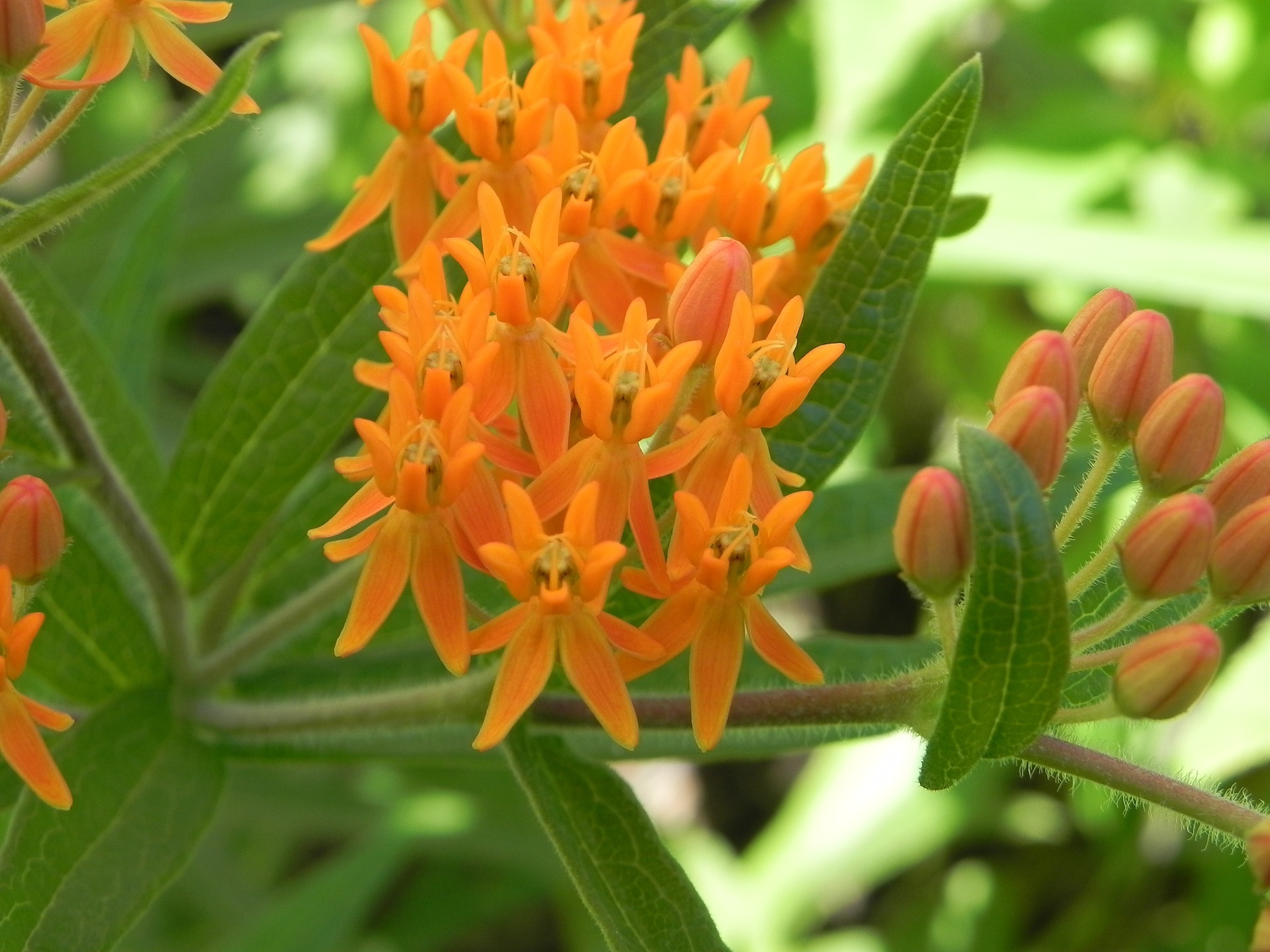
Butterfly Weed (Asclepias tuberosa)
Butterfly Weed is a milkweed species that thrives in predominantly dry and open habitats. It can be found across mid and eastern United States and the Southeast of Canada. Butterfly milkweed has bright orange and red flowers which attract many managed and wild bees, along with butterflies like Swallowtails and Monarchs. Butterfly weed is known to be the showiest of all milkweed species because of its vibrant and long-lasting flowers.
Geographic Distribution: Eastern and Southwestern United States with a strong presence in the prairies and grasslands of the Midwest and Great Plains; also in the Canadian provinces of Quebec and Ontario.
Habitat: Prairies, sandy savannas, open rocky woodlands, glades, fields, roadside embankments, and areas along railroads.
Identification: Grows up to 4’ tall. Leaves are about 3” long and ½ ” across. The stems are light green and can become a reddish purple color with hairs. Flowers develop on the upper stems with petals that are a vibrant orange color, and can appear red at certain times. Each flower consists of 5 sepals, 5 petals, 5 hoods with horns, and a central reproductive column that is white to light green and short.
Common Pollinators: Honeybees, native bees, wasps, moths, butterflies, hummingbirds, and beetles.
NatureServe Conservation Status: G5 Secure overall
https://www.illinoiswildflowers.info/prairie/plantx/btf_milkweedx.htm
https://www.fs.usda.gov/wildfl...
https://explorer.natureserve.org/Taxon/ELEMENT_GLOBAL.2.129775/Asclepias_tuberosa
https://www.wildflower.org/plants/result.php?id_plant=ASTU
Seed Sources
https://www.everwilde.com/store/Asclepias-tuberosa-WildFlower-Seed.html
https://www.prairienursery.com/butterflyweed-asclepias-tuberosa.html
https://www.selectseeds.com/milkweed-asclepias/butterfly_weed_seeds.aspx
https://www.prairiemoon.com/asclepias-tuberosa-butterfly-weed-prairie-moon-nursery.html
https://www.americanmeadows.com/wildflower-seeds/milkweed-seeds/butterfly-weed-seeds
https://www.applewoodseed.com/product/milkweed-butterfly/#results
Photo by Bill Buchanan, USFWS
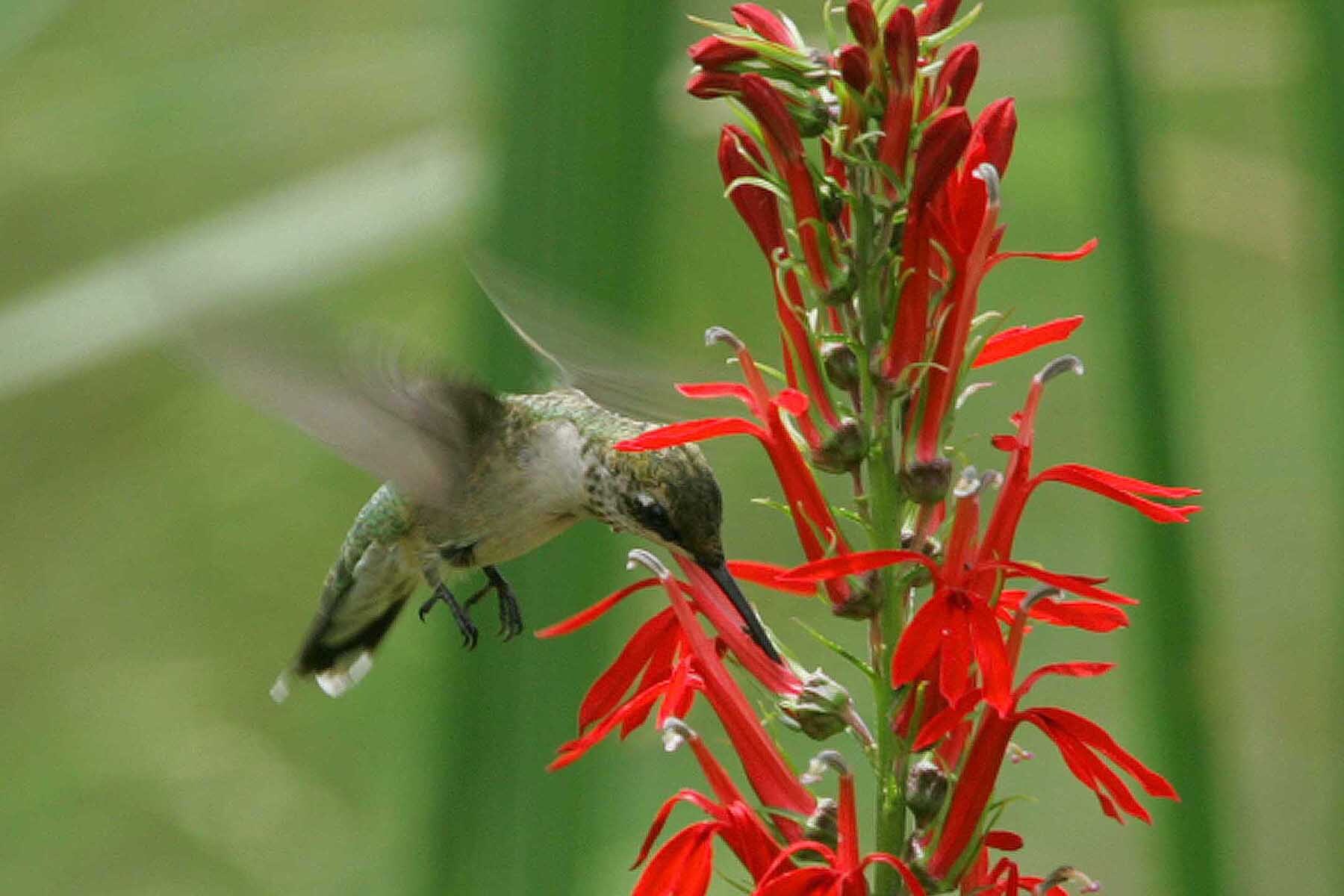
Cardinal Flower (Lobelia cardinalis)
Cardinal flower earned its name because of its showy, red flowers that resemble the vestments of Roman Catholic cardinals. The flower relies on hummingbirds for pollination since most insects have difficulty navigating the tubular flowers. Cardinal flower provides much needed nectar for the hummingbird migration in the middle to late summer. The large stalks of bright red successively blooming flowers are hard to miss and support multitudes of hummingbird along their journey. Growing in full sun and in shade, this flower is often seen along forest edges.
Geographic Distribution: Central and Eastern North America, from Minnesota to New Brunswick and south from Texas to Florida. Also in California south through Mexico and Central America to Northern South America.
Habitat: Woodland edges and openings, ravines, stream banks, open grasslands and meadows, swamps, and disturbed areas like ditches and roadsides.
Identification: Stem grows up to 4’ tall; light green and hairy. Leaves grow alternately along the stem and are up to 6” long and 1½” wide; lance-shaped and coarsely serrated; having a tendency to curl upward. Flowers grow in spike-like clusters at the end of the stem. Each flower is upright and tubular with reproductive organs above and nodding downward; 2 lateral lobes beneath and a 3-lobed lower lip; up to 1½” long and 1” wide.
Common Pollinators: Hummingbirds and butterflies.
NatureServe Conservation Status: G5 Secure overall; S3 Vulnerable in New Brunswick, S2 Imperiled in Colorado, and S1 Critically Imperiled in Nebraska and Nevada.
https://www.wildflower.org/plants/result.php?id_plant=loca2
http://www.missouribotanicalgarden.org/PlantFinder/PlantFinderDetails.aspx?taxonid=278870
https://hort.extension.wisc.edu/articles/cardinal-flower-lobelia-cardinalis/
https://www.illinoiswildflowers.info/wetland/plants/cardinal.htm
https://explorer.natureserve.org/Taxon/ELEMENT_GLOBAL.2.153707/Lobelia_cardinalis
Seed Sources
https://www.prairiemoon.com/lobelia-cardinalis-cardinal-flower-prairie-moon-nursery.html
https://www.everwilde.com/store/Lobelia-cardinalis-WildFlower-Seed.html
https://www.americanmeadows.com/wildflower-seeds/lobelia-seeds/cardinal-flower-seeds
https://www.wildflowerfarm.com/index.php?route=product/product&product_id=110
https://www.swallowtailgardenseeds.com/perennials/lobelia-perennial.html
https://www.highcountrygardens.com/wildflower-seeds/individual-species/lobelia-cardinalis-seeds
https://www.seedsource.com/catalog/detail.asp?product_id=3095
https://www.prairienursery.com/cardinal-flower-lobelia-cardinalis.html
Photo by Amber Barnes
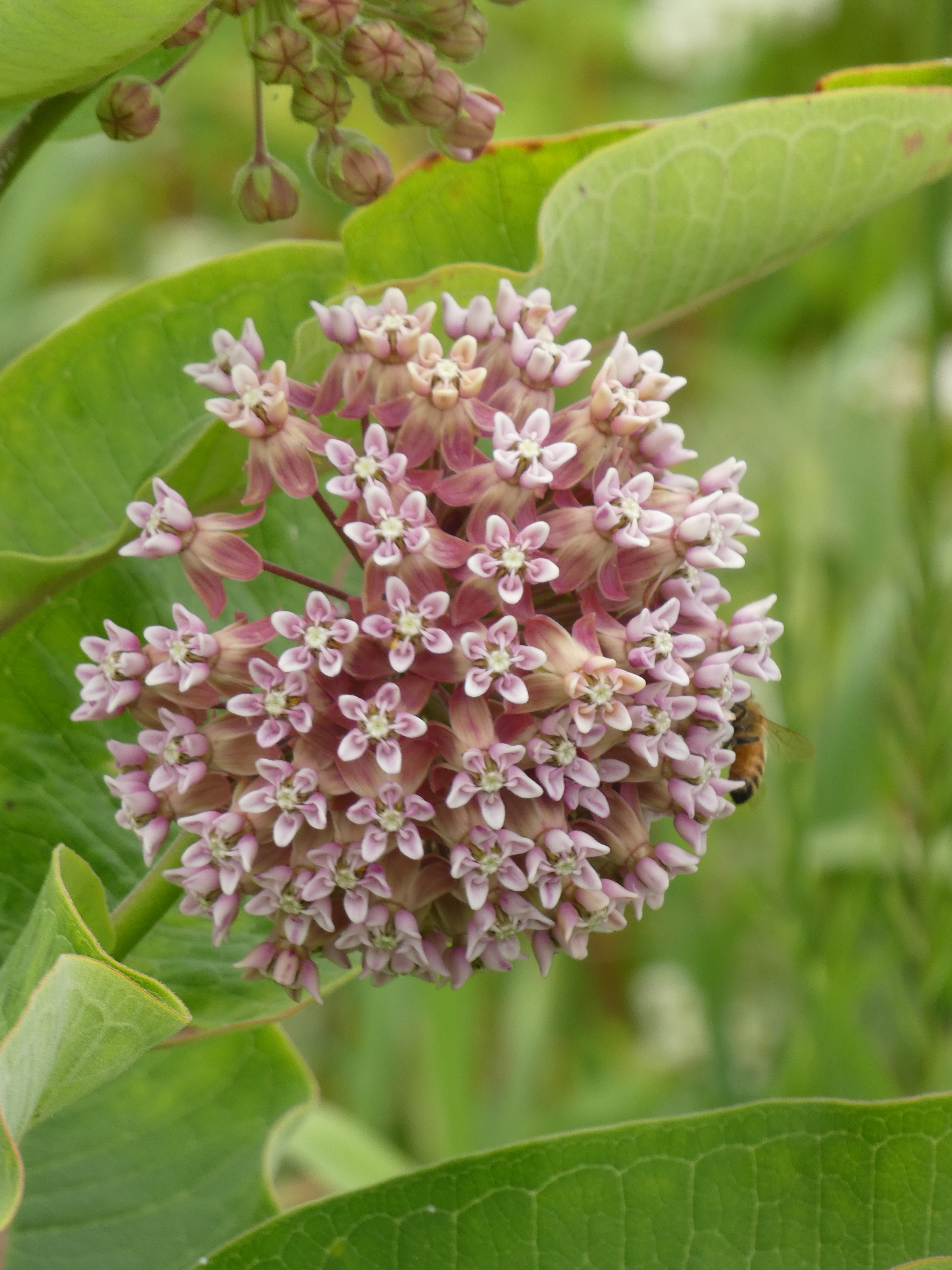
Common Milkweed (Asclepias syriaca)
Common milkweed is a tall milkweed species with pink to purple flowers that is found across much of North America, particularly the Eastern United States and a large portion of Canada. It can occupy a variety of different habitats and is a source of food for a multitude of insects and organisms, being especially important as the sole food source for monarch butterfly larvae. In the southern portion of its range, it is a colonial species that often gets outcompeted by other vegetation, but is a more permanent part of the landscape in the northern portions of its range.
Geographic Distribution: Eastern United States, prairie states, and southern Canada from New Brunswick to Saskatchewan.
Habitat: Fields, pastures, fence rows, roadsides, and wide variety of other habitats as it is a very hardy plant.
Identification: Grows up to 5’ tall. Leaves up to 8” long and 3.5” wide; upper surface is pale-medium to dark green and hairless; lower surface is densely covered with short, woolly hairs. Milky sap is released if damaged. Flowers bloom from the axils of upper leaves in pink or purple umbels up to 4” across; each is about ¼” across, consisting of 5 reflexed petals and 5 raised hoods with curved horns.
Common Pollinators: Honey bees, native bees, flies, wasps, moths, butterflies, and skippers.
NatureServe Conservation Status: G5 Secure overall; S3 Vulnerable in Manitoba.
https://www.fs.usda.gov/wildfl...
https://www.illinoiswildflowers.info/weeds/plants/cm_milkweed.htm
https://www.wildflower.org/plants/result.php?id_plant=ASSY
https://www.missouribotanicalgarden.org/PlantFinder/PlantFinderDetails.aspx?kempercode=b480
https://explorer.natureserve.org/Taxon/ELEMENT_GLOBAL.2.131135/Asclepias_syriaca
Seed Sources:
https://www.wildflowerfarm.com/index.php?route=product/product&path=18&product_id=73
https://www.everwilde.com/store/Asclepias-syriaca-WildFlower-Seed.html
https://www.prairienursery.com/common-milkweed-asclepias-syriaca.html
https://www.selectseeds.com/milkweed-asclepias/common_milkweed_seeds.aspx
https://www.prairiemoon.com/asclepias-syriaca-common-milkweed
https://www.americanmeadows.com/wildflower-seeds/milkweed-seeds/common-milkweed-seed
Photo by Amber Barnes
Gray Goldenrod (Solidago nemoralis)
Gray goldenrod, also referred to as Field Goldenrod, is a perennial plant that can reach up to 2½’ tall and thrives in soil containing sand, clay or gravel. This variety of goldenrod is often easier to identify than other Solidago species because of its short height, leaning clusters, and hairy leaves and stems. A wide variety of insects frequent the flowers of this plant, including long-tongued bees, short-tongued bees, beetles, and moths. It is a larval host for many moths. This plant is also a source of food for some vertebrate animals like birds, groundhogs, rabbits, deer, and livestock!
Geographic Distribution: Across southern Canada through much of the US east of the Rockies and Durango in northern Mexico
Habitat: Prairies, bluffs, savannahs, dunes, fields, and roadsides.
Identification: Gray Goldenrod has alternating leaves that grow up 4” long and ¾” across. The stem culminates in a vibrant yellow flowerhead which tends to lead over. Each flowerhead is about ¼” across and has 4-10 florets that surround others.
Common Pollinators: Honey bees, native bees, wasps, flies, butterflies, moths, beetles.
NatureServe Conservation Status: G5 Secure overall; S3 Vulnerable in Wyoming.
https://www.illinoiswildflowers.info/prairie/plantx/fld_goldenrodx.htm
https://www.wildflower.org/plants/result.php?id_plant=SONE
https://explorer.natureserve.org/Taxon/ELEMENT_GLOBAL.2.158164/Solidago_nemoralis
https://www.minnesotawildflowers.info/flower/gray-goldenrod
Seed Sources:
https://www.applewoodseed.com/product/goldenrod-gray/
https://www.everwilde.com/store/Solidago-nemoralis-WildFlower-Seed.html
https://www.prairiemoon.com/solidago-nemoralis-old-field-goldenrod-prairie-moon-nursery.html
Photo by Sten Own, courtesy of Wikimedia Commons CC BY-SA 3.0
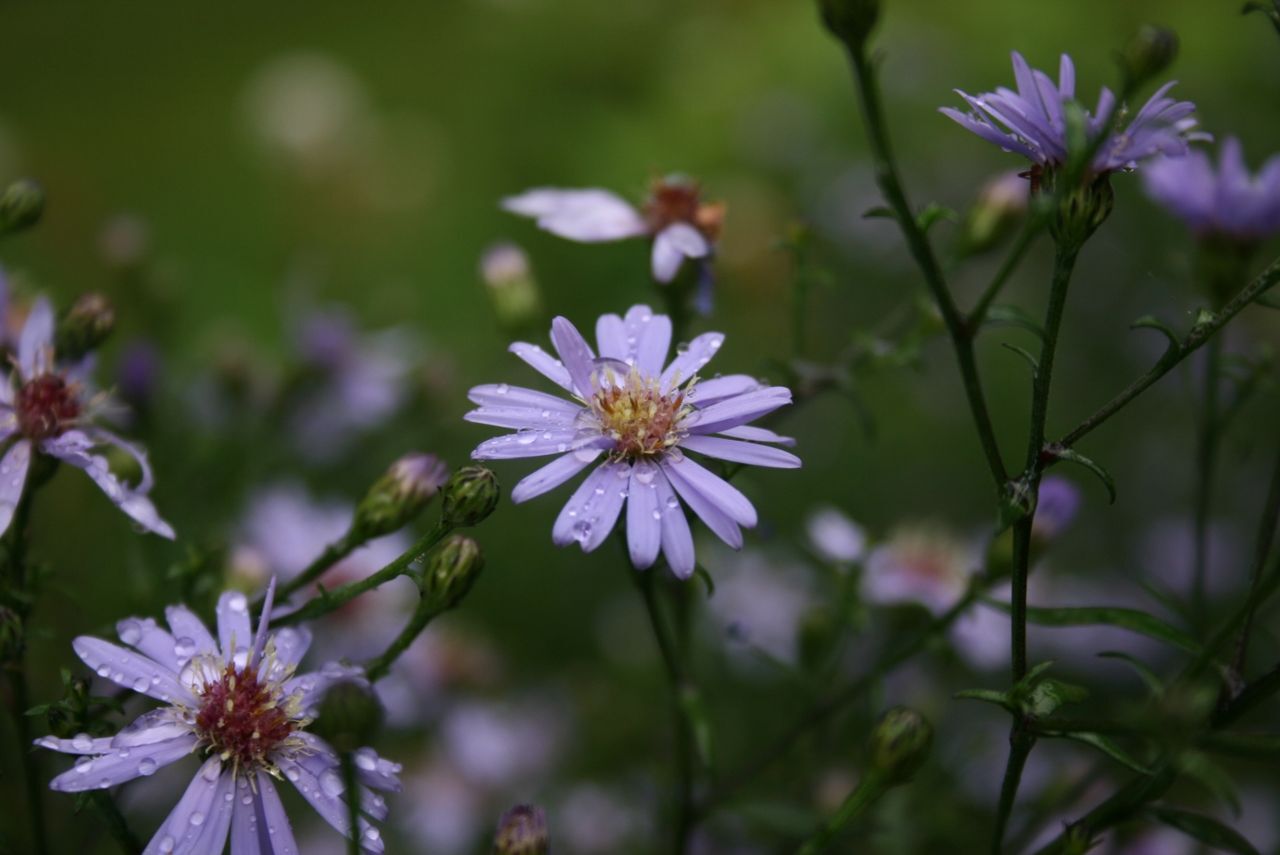
Heart-Leaved Aster (Symphyotrichum cordifolium)
Also known as blue wood aster or broad-leaved aster, heart-leaved aster is a perennial plant in the Aster family. It usually prefers partial shade and moist, rich soils that are well drained, and blooms during the summer and into the late fall. Although known for attracting butterflies, bees are its most important pollinator. The aster is also an important food source for several species of butterfly and moth larvae.
Geographic Distribution: Central to Eastern North America from Manitoba to Quebec, south to Kansas and Florida.
Habitat: Usually found in partly shaded areas such as woodlands, forest edges, fields, dry meadows, and stream banks.
Identification: Stem grows up to 4’ tall; reddish brown to light green. Leaves are alternate, up to 5” long and 3” wide; dark green on the upper surface and light green on the underside; lower leaves are heart-shaped, becoming ovate farther up the stem; coarsely serrated. The upper stem ends in a panicle of flowers from 6-18” long. Each flower is lavender to white in color, about ½” wide, and is made up of 7-15 ray florets and the same number of disk florets. The tubular corollas are cream-colored, becoming purple with age.
Common Pollinators: Butterflies, native bees, wasps, flies, skippers, and beetles.
NatureServe Conservation Status: G5 Secure overall; S3 Vulnerable in Missouri and S1 Critically Imperiled in Kansas.
https://www.wildflower.org/plants/result.php?id_plant=syco4
https://www.missouribotanicalgarden.org/PlantFinder/PlantFinderDetails.aspx?kempercode=a788
https://www.illinoiswildflowers.info/woodland/plants/bl_woodaster.htm
https://www.minnesotawildflowers.info/flower/blue-wood-aster
https://explorer.natureserve.org/Taxon/ELEMENT_GLOBAL.2.158910/Symphyotrichum_cordifolium
https://www.amandasnativeplants.com/product-page/symphyotrichum-cordifolium-blue-wood-aster
https://www.prairienursery.com/heart-leaved-aster-aster-cordifolius.html
https://plants.ces.ncsu.edu/plants/symphyotrichum-cordifolium/
http://www.newmoonnursery.com/plant/Aster-cordifolius
Seed Sources
https://www.prairiemoon.com/symphyotrichum-cordifolium-heart-leaved-aster
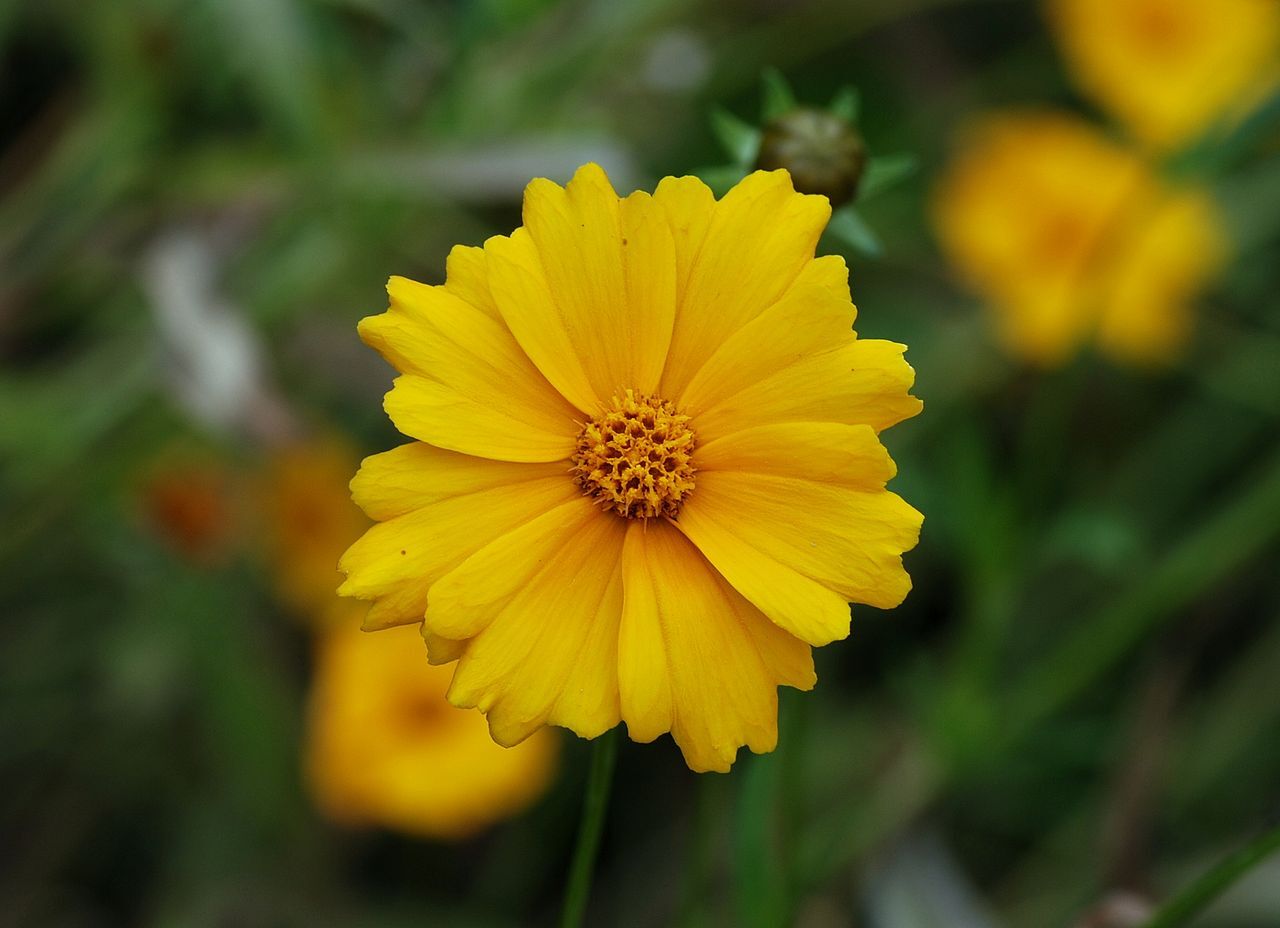
Lance-Leaved Coreopsis (Coreopsis lanceolata)
The Lance-Leaved Coreopsis, also known as Sand Coreopsis, is a perennial plant that is part of the Aster family. It typically thrives in sandy soil and blooms during the Summer. It is the larval host of several moths (Dimorphic Gray, Wavy-lined Emerald, Common Tan Wave. This plant occurs throughout much of the United States and Canada. It is frequently recognized by its leaves, which occur mainly on the lower half of the stem.
Geographic Distribution: Majority of the eastern United States, naturalized in the Northeastern states; BC and ON provinces of Canada.
Habitat: Open woodlands, Prairie, Plains, Meadows, Pastures, Savannas
Identification: Grows up to 36 inches tall. Leaves are up to 8” long and about 1” wide. The leaves decrease in size as they ascend the stem. At the top of the stem are single flowers, 2-3 inches across with 4 yellow petals. The flower stalks are hairless similar to the stems.
Common Pollinators: Native bees, wasps, flies, butterflies, skippers, day-flying moths, and beetles.
NatureServe Conservation Status: G5 Secure overall; S2 Imperiled in Kansas and Wisconsin.
https://www.illinoiswildflowers.info/prairie/plantx/sand_coreopsisx.htm
https://www.wildflower.org/plants/result.php?id_plant=COLA5
https://explorer.natureserve.org/Taxon/ELEMENT_GLOBAL.2.140944/Coreopsis_lanceolata
https://www.minnesotawildflowers.info/flower/lanceleaf-coreopsis
Seed Sources:
https://www.everwilde.com/store/Coreopsis-lanceolata-WildFlower-Seed.html
https://www.prairienursery.com/lanceleaf-coreopsis-coreopsis-lanceolata.html
https://www.selectseeds.com/annuals/cuphea_purple_passion_seeds.aspx
https://www.prairiemoon.com/coreopsis-lanceolata-lance-leaf-coreopsis-prairie-moon-nursery.html
https://www.applewoodseed.com/product/coreopsis-lance-leaved/
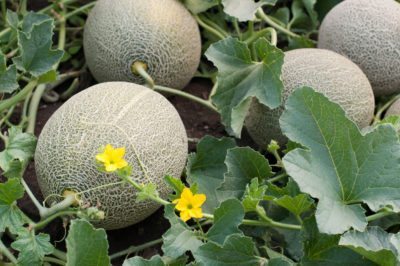
Melon (Cucumis melo)
Melon, also called cantaloupe or honeydew, is originally native to East Africa and Central Asia, arriving in Europe in the 1200s. Now the plant is cultivated worldwide. In Panama, it has even been grown at over 7,000 ft in elevation. The fruit is widely consumed for its juice and flesh, but melons have a variety of other ethnobotanical uses including for cooking powder and edible oil. Medicinally, melons are used to promote skin hydration, treat light burns and abrasions, and as stomach tonic. Seeds can be used as a vermifuge.
Geographic Distribution: Grown and escaped throughout much of the United States, especially in the East, and in Ontario.
Habitat: Rivers, open woodlands, abandoned fields, and disturbed sites; prefers open habitats with well-drained, deep soils.
Identification: Stems are trailing and hairy, reaching up to 10’ long. Leaves are simple and grow alternately along the stem; leaves are rounded and toothed with 3-7 shallow, palmate lobes; cordate bases and long petioles, with unbranched tendrils at the petiole base; hairy; leaves up to 6” long and 6” wide. Flowers are 1” across, having 5 yellow petals and produce a round berry usually weighing around 5 lbs. Berries are highly variable in color (yellow, green, orange, white) and often mottled or striped; flesh can be yellow, orange, pink, white, or green.
Common Pollinators: Bees, especially squash bees and honey bees.
NatureServe Conservation Status: Exotic in the United States and Canada.
Resources:
http://climbers.lsa.umich.edu/?p=250
https://www.honey-plants.com/calendar/illinois/cucumis-melo/
https://pfaf.org/user/Plant.aspx?LatinName=Cucumis+melo
https://explorer.natureserve.org/Taxon/ELEMENT_GLOBAL.2.158812/Cucumis_melo
Seed Sources:
https://www.johnnyseeds.com/vegetables/melons/
Mexican Marigold (Tagetes lemmonii)
Mexican Marigold, also known as Lemmon’s Marigold, is an herbaceous annual plant that is part of the Aster family. It can be found in the Southwestern United States into Mexico and Central America, as it thrives in full sun. Its bright orange-yellow flowers bloom late fall to spring. Although it enjoys full sun, Mexican Marigold is not tolerant of desert heat if planted in western exposures and can also be damaged by cold temperatures below 20˚F.
Geographic Distribution: Southwestern United States (mainly Arizona) into Mexico and Central America.
Habitat: Moist canyon grasslands, woodlands, near streams.
Identification: Grows rapidly up to 8’ tall. Leaves are dark green with tinges of reddish bronze and have a strong and pageant smell of lemon and mint. Leaves are narrow, reaching up to 4 inches long. The flowers look similar to daisy flowers, and have an orange-yellow color.
Common Pollinators: Honeybees, native bees, and butterflies.
NatureServe Conservation Status: G4 Apparently Secure in Arizona.
http://www.public.asu.edu/~camartin/plants/Plant%20html%20files/tageteslemmonii.html
https://www.sfbg.org/copy-of-cestrum-elegans-july-1
https://explorer.natureserve.org/Taxon/ELEMENT_GLOBAL.2.143917/Tagetes_lemmonii
https://www.selectseeds.com/all-items/signet_marigold_lemon_gem_seeds.aspx
Seed Sources
https://www.selectseeds.com/all-items/signet_marigold_lemon_gem_seeds.aspx
Photo by Amber Barnes
Purple Coneflower (Echinacea purpurea)
Purple Coneflower is a perennial plant in the Aster family and it thrives in partial to full sun. It can be found in much of the Eastern and Southern United States. You’ll find its vibrant purple flowers (and sometimes, but rarely, white) in the late Summer to early Fall. The Purple Coneflower is a larval host of the SIlvery Checkerspot Butterfly along with several species of moth. In the Summer and early Fall, the Eastern Goldfinch occasionally eats the seeds of this plant. The genus name, “Echinacea”, is from the Greek word “echinos'', meaning “hedgehog”, which alludes to round and spiny appearance of the flower's central disk.
Geographic Distribution: Southern and Eastern United States; Ontario province of Canada.
Habitat: Moist to mesic black soil prairies, edges and openings in woodlands, savannas, thickets, and limestone glades.
Identification: Grows up to 3 ½ feet tall. The leaves alternate, and are up to 6 inches long and 3 inches wide. Each leaf has up to 5 veins that stretch along the length. The edges of the leaves are serrated with minute and appressed hairs. The stems are light green with scattered white hairs. The stems terminate in a single flower with 15-20 rich pink-purple petals, each petal being up to 3” long and ¾” wide. The center disk is a bright orange yellow.
Common Pollinators: Long-tongued bees, bee flies, Halictid bees, butterflies, skippers, moths.
NatureServe Conservation Status: G4 Apparently Secure overall; S3 Vulnerable in MS and AL; S2 Imperiled in LA, GA, and IA; S1 Critically Imperiled in KS, NC, and FL; SX Presumed Extirpated in MI.
https://www.illinoiswildflowers.info/prairie/plantx/pur_coneflowerx.htm
https://www.wildflower.org/plants/result.php?id_plant=ECPU
https://explorer.natureserve.org/Taxon/ELEMENT_GLOBAL.2.132226/Echinacea_purpurea
https://www.minnesotawildflowers.info/flower/eastern-purple-coneflower
http://www.missouriplants.com/Echinacea_purpurea_page.html
Seed Sources
https://www.everwilde.com/store/Echinacea-purpurea-WildFlower-Seed.html
https://www.prairienursery.com/purple-coneflower-echinacea-purpurea.html
https://www.selectseeds.com/perennial-seeds-2/coneflower_rubinstern_ruby_star_seeds.aspx
https://www.prairiemoon.com/echinacea-purpurea-purple-coneflower-prairie-moon-nursery.html
https://www.americanmeadows.com/wildflower-seeds/coneflower-seeds/purple-coneflower-seeds
Photo by Larry Stritch
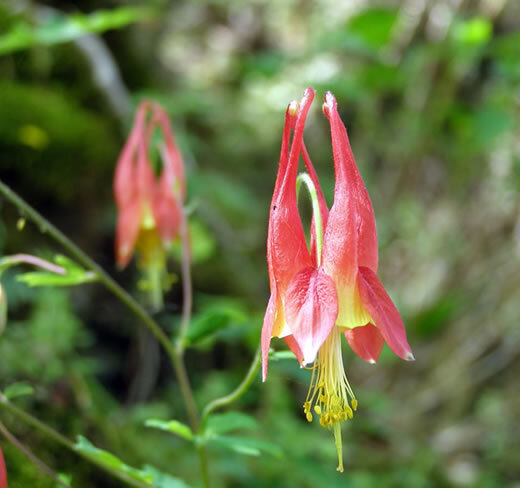
Red Columbine (Aquilegia canadensis)
The only native columbine to eastern North America, “Aquilegia” comes from Latin, meaning “eagle”, due to the resemblance of the spurred petals to eagle talons. It grows to about 3’ in height, and its distinctive red and yellow flowers can bloom from February to July depending on latitude. The downward facing, bell-like flowers feature backward-pointing spurs containing nectar that attracts hummingbirds and long tongued-insects. Red columbine is also an important nectar source for hummingbirds. It can grow in a variety of different conditions from woodland edges to river banks, alongside shores, and ridges. Red columbine is a larval host for columbine duskywing moths (Erynnis lucilius) and borer moths (Papaipema leucostigma).
Geographic Distribution: Eastern Canada and United States; from Saskatchewan to Quebec, south to Arkansas and Georgia, with a disjunct population in central Texas.
Habitat: Shaded areas, especially woodland habitat, with rocky or sandy soils; sandy savannas, shaded cliffs, fens and bogs, and in disturbed areas.
Identification: Stems are round, reddish green, and may be either smooth or hairy, reaching up to 3’ tall. After the basal leaves, leaves grow alternately along the stem; leaves are divided into 3 leaflets and either smooth or hairy; each leaflet is obovate with 3 lobes and up to 3” long and 2” across; secondary lobes may be present. Flowers hang downward from the upper stems, having 5 petals and sepals, growing to 1 ½” long, and featuring nectar spurs and exerted stamens and styles; spurs and sepals are red to purple and anthers are bright yellow.
Common Pollinators: Hummingbirds, long-tongued bees, butterflies, and hawk moths.
NatureServe Conservation Status: G5 Secure overall; S2 Imperiled in Delaware; S1 Critically Imperiled in Florida and Mississippi.
https://www.wildflower.org/plants/result.php?id_plant=AQCA
https://www.illinoiswildflowers.info/woodland/plants/wild_columbine.htm
https://www.missouribotanicalgarden.org/PlantFinder/PlantFinderDetails.aspx?kempercode=b400
https://www.fs.usda.gov/wildfl...
https://www.fs.usda.gov/wildfl...
https://explorer.natureserve.org/Taxon/ELEMENT_GLOBAL.2.135388/Aquilegia_canadensis
Seed Sources
https://seedcorner.com/columbine-eastern-red-aquilegia-canadensis-seeds/
https://www.americanmeadows.com/wildflower-seeds/columbine-seeds/eastern-red-columbine-seeds
https://www.prairiemoon.com/aquilegia-canadensis.html
https://www.everwilde.com/store/Aquilegia-canadensis-WildFlower-Seed.html
https://www.wildflowerfarm.com/index.php?route=product/product&product_id=57
https://www.prairienursery.com/columbine-aquilegia-canadensis.html
White Penstemon (Penstemon albidus)
White Penstemon, also known as White beardtongue is a densely flowered perennial that is in the Plantain family. It’s unique flowers can be observed during late Spring to early Summer and thrive in partial shade to full sun. While Penstemon species used to be in the Figwort family (Scrophulariaceae), they are now in the Plantain family (Plantaginaceae). White penstemon can be found in the middle of North America.
Geographic Distribution: Central United States (MT to MN and TX to ND) and Canadian provinces of AB, SK, MB, and ON.
Habitat: Gravel and sandy grasslands, dry prairies, hillsides.
Identification: Grows up to 1 foot tall, with a stout and erect stem. The basal leaves are broad and rough: 2 ½” long and ½” wide with a rounded tip. Leaves become stalkless as they ascend the stem with serrated edges and pointed at the tip. There are typically 2 to 5 stems arising from the base of the plant. Clusters of at least two white, trumpet shaped flowers arise in the upper part of the plant. Flowers are up to ¾” long and have 3 lobes pointing downward and 2 lobes pointing upward, the bottom lobes being slightly larger than the top lobes.
Common Pollinators: Native bees, honey bees, wasps.
NatureServe Conservation Status: G5 Secure overall; S3 Vulnerable in Canadian provinces of AB and MB; S2 Imperiled in IA.
https://www.wildflower.org/plants/result.php?id_plant=PEAL2
https://explorer.natureserve.org/Taxon/ELEMENT_GLOBAL.2.140952/Penstemon_albidus
https://www.minnesotawildflowers.info/flower/white-beardtongue
Seed Sources
https://prairielegacyinc.com/shop/wildflowers/penstemon-albidus-white-penstemon/
Featured Pollinators
Photo by Mike Goad
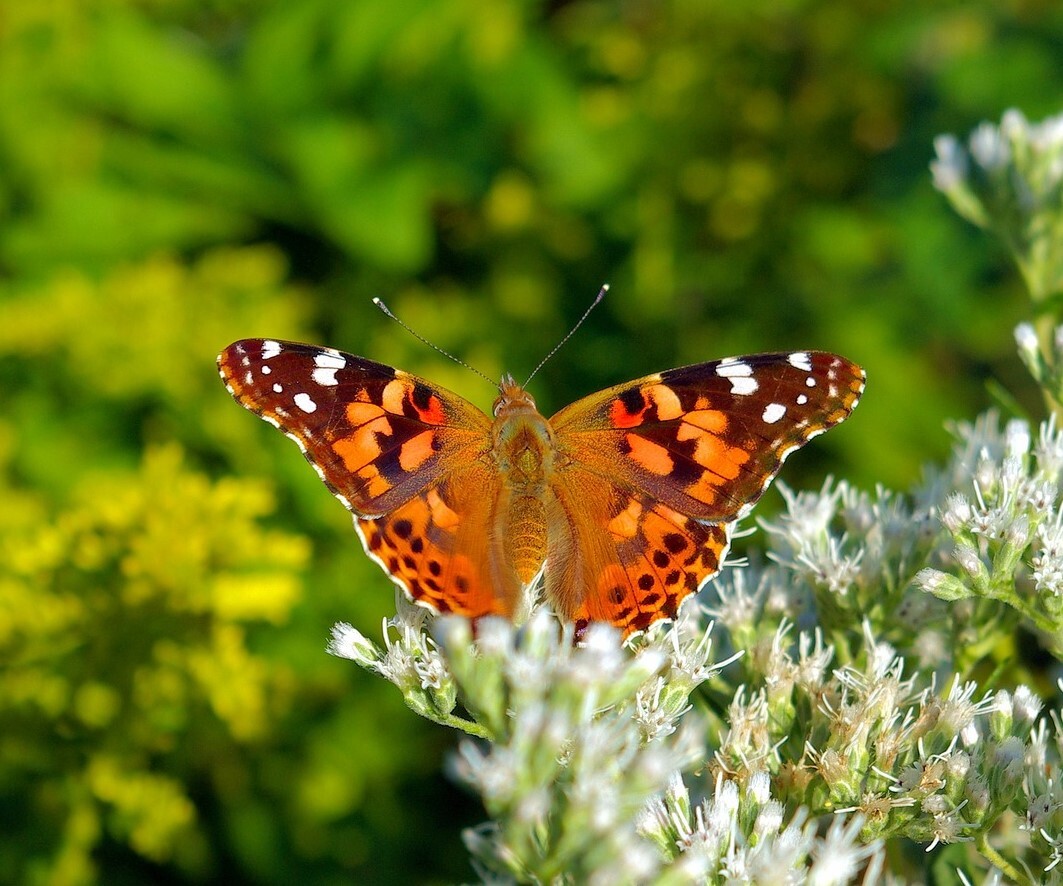
American Lady (Vanessa virginiensis)
The American lady ranges across most of North America and is best known for the characteristic nests made by its caterpillar. These nests are made by the silking together of leaves and chaff at the tips of flower stalks, allowing the caterpillars to hide during the day and come out at night. Preferred larval hosts are members of the Aster family. The adult can be distinguished from similar species by its brighter orange color and the two prominent eyespots on its wings.
Geographic Distribution: A resident of the southern United States, Mexico, and Central America. Migrates to the northern United States and southern Canada. Occasionally seen in Europe, Hawaii, and the Caribbean.
Habitat: Open areas with low vegetation such as meadows, forest edges, sandy areas, lawns, roadsides, and vacant lots.
Identification: Top of the wing is orange and brown with black margins. Forewings have white spots on the outer edges. The bottom of each hindwing has two large eyespots and a “cob-web” pattern, while the bottom of the forewing has a bright pink area. The early season form is more brightly colored, while the late season form is paler in color. Caterpillars are either greenish-yellow with black rings or black with cream rings; dark, branched spines that are red at the base; white spots on each segment.
Size: Wingspan is 1¾” - 2½”.
Plants Commonly Visited: Larvae feed on everlastings, cudweeds, and pussytoes. Other plants are also visited by the adults for nectar.
Natureserve Conservation Status: G5 Secure overall; S3 Vulnerable in Utah.
https://www.butterfliesandmoths.org/species/Vanessa-virginiensis
http://entnemdept.ufl.edu/creatures/bfly/american_lady.htm
https://edis.ifas.ufl.edu/in823
https://bugguide.net/node/view/488
https://wisconsinbutterflies.org/butterfly/species/90-american-lady
https://alabama.butterflyatlas.usf.edu/species/details/152/american-lady
https://butterfly-fun-facts.com/american-lady-vanessa-virginiensis/
https://explorer.natureserve.org/Taxon/ELEMENT_GLOBAL.2.120583/Vanessa_virginiensis
Calligrapher Fly (Toxomerus marginatus)
Flies are one of the many insects that are not immediately associated as pollinators, yet there are many flies that gather pollen as they visit flower to flower drinking nectar. The calligrapher fly, also known as a hover fly, is part of the Syrphid family which consists of flies that frequently “hover” over flowers. Calligrapher flies can be easily identified by a round spot near the end of their abdomen. These flies are great mimics of wasps with similar colors and banding on the abdomen, but upon a closer look, their eyes and antennae are much different than those of wasps.
Geographic Distribution: All of the United States, Mexico, and Canada.
Habitat: Meadows, gardens, and open woodlands.
Identification: Yellowish-orange bodies with black stripes and a black round dot towards the end of the abdomen. Up to 0.23” in length. The females have eyes that are separated while male eyes are directly next to each other. They hover like many bees do, but are much smaller than bees.
Size: 0.19” to 0.23” in length.
Plants Commonly Visited: A wide variety of blooming flowers.
Natureserve Conservation Status: G5 Secure Overall.
http://nathistoc.bio.uci.edu/diptera/Toxomerus.htm
https://explorer.natureserve.org/Taxon/ELEMENT_GLOBAL.2.896445/Toxomerus_marginatus
https://www.discoverlife.org/20/q
https://animaldiversity.org/accounts/Toxomerus_marginatus/classification/#Toxomerus_marginatus
Photo by Anthony Colangelo
Honey Bee (Apis mellifera)
One of the most charismatic pollinators, honey bees are easily identified by their black bands and orange-yellow rings on their abdomens. The honey bee is a colonial species, living in hives built from wax secretions. The majority of the hive members are sterile female workers, with the queen being the only reproductive member. This species is commonly managed for its honey production and crop pollination services and has been introduced globally. In the United States, honey bees are a complex of several interbred European subspecies.
Geographic Distribution: Native to Europe, western Asia, and Africa; introduced globally.
Habitat: Meadows, gardens, and open woodlands; also able to survive in deserts, grasslands, and wetlands.
Identification: reddish-brown bodies with black bands and orange-yellow rings on the abdomen. Dark legs with pollen baskets on the hind legs.
Size: less than 1” long.
Plants Commonly Visited: A wide variety of blooming flowers.
Natureserve Conservation Status: GNR Not Ranked.
https://animaldiversity.org/accounts/Apis_mellifera/
http://entnemdept.ufl.edu/creatures/misc/BEES/euro_honey_bee.htm
https://www.discoverlife.org/mp/20q?search=Apis+mellifera
https://explorer.natureserve.org/Taxon/ELEMENT_GLOBAL.2.110276/Apis_mellifera
Margined Soldier Beetle (Chauliognathus marginatus)
The margined soldier beetle, also known as the Margined Leatherwing Beetle, is a beetle that resembles a firefly, and is very similar in appearance to its relative, the Pennsylvania Leatherwing. You’ll find the Margined Soldier Beetle active in the Spring. The texture of the beetle resembles leather, hence the name “leatherwing”. The larvae of these beetles are known to prey on and consume pest insects, which benefit gardeners greatly.
Geographic Distribution: Indiana and Canadian Provinces of ON and NB.
Habitat: Prairies, fields, meadows, gardens.
Identification: Yellow and black smooth coat with black antennae. Approximately ½” long. The wings are filled with a black center towards the rear while the edges fade out to a yellowish-orange edge. A majority of the beetle is yellow in color, while the shoulders are more black.
Size: 0.35” to 0.47” in length.
Plants Commonly Visited: A wide variety of blooming flowers (Hydrangea, Linden, New Jersey tea).
Natureserve Conservation Status: GNR Not Ranked.
https://explorer.natureserve.org/Taxon/ELEMENT_GLOBAL.2.918068/Chauliognathus_marginatus
https://blogs.ext.vt.edu/ag-pest-advisory/predator-profile-leatherwings-soldier-beetles/
Metallic Sweat Bee (Augochloropsis metallica)
The metallic sweat bee is ubiquitous throughout much of the United States and Mexico, and is known for its brilliant, metallic green body. This bee is ground-nesting, digging a long burrow that extends straight down, from which a single lateral burrow that cells hang down from extends horizontally.
Geographic Distribution: In the United States from the Atlantic coast to South Dakota in the Northwest of its range and Arizona in the Southwest of its range; south to Panama; also present in Ontario.
Habitat: A wide variety of landscapes including prairies, meadows, and woodlands.
Identification: brilliant green body and black mandibles. In males, the end of the legs are yellowish, and the rest of the legs are green. In females, the end of the legs are brownish, and the legs become greener toward the base. Wings are transparent with visible venation.
Size: 0.35” in length.
Plants Commonly Visited: A wide variety of blooming flowers and flower families, including the Aster, Chrysanthemum, Dogwood, Geranium, Holly, Sumac, Rose, and Goldenrod families.
Natureserve Conservation Status: GNR Not Ranked.
https://www.marylandbiodiversity.com/view/3146
https://bugguide.net/node/view/82742
https://www.discoverlife.org/mp/20q?search=Augochloropsis+metallica
https://explorer.natureserve.org/Taxon/ELEMENT_GLOBAL.2.882081/Augochloropsis_metallica
Orchard Mason Bee (Osmia lignaria)
Orchard mason bees are members of the genus Osmia, which encompasses all mason bees. Generally, mason bees are known for pollinating fruit trees (hence “orchard” bee). Orchard mason bees are distinguished by their nest building: they use clay to make partitions and to seal the entrance of their nest (hence “mason” bee). Orchard mason bees also carry pollen on their bellies, rather than on their hind legs. Also called the blue orchard bee, Osmia lignaria are one of the few native pollinators that are managed in agriculture, and are prized for their efficiency in pollinating fruit trees such as apples, plums, pears, almonds, and peaches.
Geographic Distribution: Throughout much of the United States and Canada. Not found in Florida and portions of the southeastern Gulf Coast due to warm winter temperatures.
Habitat: Woodlands, forest edges, agricultural crop fields, managed habitats.
Identification: A dark-metallic blue. Carry pollen on their stomachs, not their hind legs. Body is covered by small hairs, which collect pollen. Can sometimes be mistaken for a black fly when in flight. Males are distinguished by long antennae and a lightly colored hair tuft on the head.
Size: Female, 10-11 mm; Male, 9-10 mm.
Plants Commonly Visited: Fruit trees - Prunus spp., quince, blueberry, other blooming flowers
Natureserve Conservation Status: G5 Secure overall; S3 Vulnerable in Indiana.
https://www.fs.usda.gov/wildfl...
https://bugguide.net/node/view/103986
https://explorer.natureserve.org/Taxon/ELEMENT_GLOBAL.2.836398/Osmia_lignaria
http://entnemdept.ufl.edu/creatures/MISC/BEES/blue_orchard_bee.htm
Photo by Bernie Paquette, courtesy of iNaturalist (CC BY 4.0)
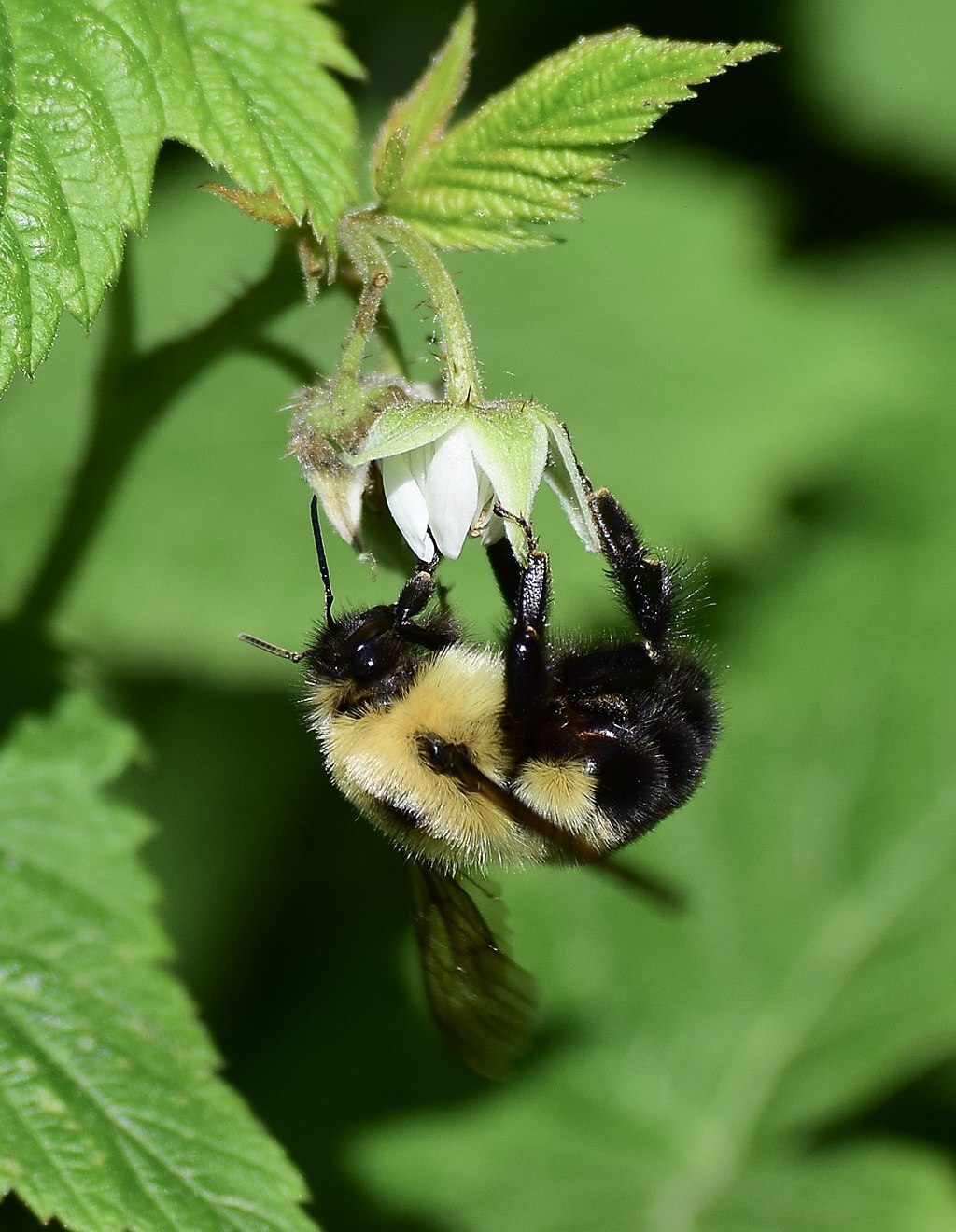
Two-Spotted Bumble Bee (Bombus bimaculatus)
The two-spotted bumble bee is identifiable by its distinctive black thorax spot and yellow “W” on its abdomen. It is a colonial species, each colony being composed of a single queen and female workers - usually not more than 80 bees total. Only new, mated queens overwinter, emerging in spring to find a new nest site and lay eggs for the new colony. This bee is known to nest underground, in cavities, and on the ground surface.
Geographic Distribution: Throughout eatsern North America; from Ontario and Maine in the north, south to Florida, and west to the Great Plains.
Habitat: Fields, woodlands, gardens, and urban areas.
Identification: Black face and yellow vertex on the head; yellow thorax with a black spot; front portion of the abdomen is yellow, ending with a yellow “W” shape, and the back portion is black. Males may have a yellow face, may not have the black spot on the thorax, and have varied abdominal color patterns.
Size: Queens are 0.75”-1” long and workers are 0.3”-0.5” long.
Plants Commonly Visited: Clovers, goldenrods, blueberries, vetches, plums, bee balms, honeysuckles, and thistles among others.
Natureserve Conservation Status: G5 Secure overall; S3 Vulnerable in Oklahoma.
http://entnemdept.ufl.edu/creatures/misc/bees/bumble_bees.htm
https://beespotter.org/topics/bio/Bombus/bimaculatus/index.html
https://wiatri.net/inventory/bbb/resources/SpeciesDetail.cfm?ESTID=11437
http://fieldguide.mt.gov/speciesDetail.aspx?elcode=IIHYM24270
https://www.discoverlife.org/mp/20q?search=Bombus+bimaculatus
https://wisconsinbumblebees.entomology.wisc.edu/online-guide/species/two-spotted-bumble-bee/
https://explorer.natureserve.org/Taxon/ELEMENT_GLOBAL.2.744949/Bombus_bimaculatus
Two-Spotted Miner Bee (Andrena accepta)
The two-spotted miner bee is a solitary ground-nesting bee part of the Genus Andrena, also called Andrenid bees or mining bees. Andrenid bees are mostly specialist pollinators whose life cycle is timed to correspond precisely to the blooming of specific flowers. Andrenids are fairly small bees, usually dark-colored, and often banded. The two-spotted miner bee, along with many other species of miner bees, make nests underground with a little pile of dirt near the entrance, sometimes concealed by a leaf or other object providing shelter.
Geographic Distribution: Throughout much of the United States, primarily in GA, ID, IN, MN, NC and into northern Mexico.
Habitat: Deserts, dry fields and prairies, sandy areas with little vegetation, barren hiking trails, and dirt roads.
Identification: A black head with small yellow areas and a black thorax. Black bands and orange-yellow rings on the abdomen. Thin hairs make up a majority of the body's surface. The genal area is broad, being considerably broader than the eye in lateral view.
Size: ⅜ to ¾ inch in length.
Plants Commonly Visited: Helianthus spp., Symphyotrichum spp., Coreopsis spp., Bidens spp., and Silphium spp.
Natureserve Conservation Status: GNR Not Ranked; S3 Vulnerable in Indiana; SH Possibly Extirpated in North Carolina.
https://explorer.natureserve.org/Taxon/ELEMENT_GLOBAL.2.881883/Andrena_accepta
https://www.discoverlife.org/20/q?search=Andrena+accepta
https://nature.mdc.mo.gov/discover-nature/field-guide/andrenid-bees-miner-bees
Science Advisors

Dr. Gary Krupnick is the head of the Plant Conservation Unit in the Department of Botany, National Museum of Natural History at the Smithsonian Institution in Washington, D.C. His research examines how data from herbarium specimens can be used in assessing the conservation status of plant species. Gary serves on the Steering Committee of the North American Pollinator Protection Campaign.

Dr. Kimberly Winter is the NatureWatch National Program Manager for the U.S. Forest Service in Washington, D.C. She holds a Ph.D. in Wildlife Ecology and Management and a Master’s degree in Ecological Anthropology. Throughout her career, Kim has sought ways to bring the value of conservation to the public eye by promoting opportunities for general audiences to immerse themselves fully in nature, whether through programs like freshwater snorkeling, special events hosted by National Forests and Grasslands like Fishing Days, Bat Week, and Pollinator Week; or online using wildlife critter cams and the NatureWatch website.
Dr. Lora Morandin has been doing research on bees and pollination since 1997. She earned her PhD from Simon Fraser University in British Columbia studying modern agriculture and pollinators, followed by post-doctoral research at the University of California, Berkeley working on enhancement of native pollinators and natural enemy insects through small-scale farm restoration. Lora has co-authored books and book chapters, created outreach and technical guides, and has about 30 peer-reviewed publications on pollinators and sustainable agriculture, including innovative work on economic benefits of ecosystem services. She has consulted for government and industry on diverse ecological topics such as greenhouse coverings, seabird oiling from offshore oil and gas operations, and honey bee health research gaps.

Miles Dakin is Pollinator Partnership's Bee Friendly Farming Coordinator. He has a Master’s at UC Davis in Entomology where he studied Navel Orangeworm in almonds and pistachios. He grew up on a small farm in Sonoma County and received his Bachelor’s in Ecology and Computer Science from Tulane University in 2017. His career interests have always been focused on integrating science and technology with land management, conservation, and education.
Poster Sponsors
The Agricultural Research Service is the chief research for the Department of Agriculture. With 660 research projects and a $1.4 billion budget, the ARS focuses on finding solutions to our every day agricultural problems.
With 6,800 almond growers and 100 processors, the Almond Board of California represents these third and fourth generation farmers through investment in research and innovative ways to grow successful almonds.
American Beauties Native Plants helps provide its consumers plants for the survival of pollinators. By supplying the right seeds and plants for any habitat, American Beauties Native Plants helps ensure that each habitat is beneficial to the bees, birds, and many other insects.
The American Beekeeping Federation focuses on the success of honeybees and beekeepers small and large. Beekeepers rely on the educational information that this Beekeeping Federation provides through research in shrinking habitats, diseases, and other related honey bee issues.
The American Honey Producers Association is an organization created by beekeepers for beekeepers that was founded in 1969. This organization dedicates all their efforts towards legislation and research in order to help all beekeepers and support their general welfare.
The Animal and Plant Health Inspection Service is an agency of the United States Department of Agriculture. APHIS focuses on the plant and animal health and welfare through the protection and promotion of food, agriculture, and natural resources.
At BASF, we create chemistry for a sustainable future. We combine economic success with environmental protection and social responsibility. The approximately 122,000 employees in the BASF Group work on contributing to the success of our customers in nearly all sectors and almost every country in the world.
Bayer is a Life Science company with a more than 150-year history and core competencies in the areas of health care and agriculture. With our innovative products, we are contributing to finding solutions to some of the major challenges of our time.
The Bee Friendly Farming (BFF) programs recognize, engage, and support BFF participants and pollinators everywhere. The BFF program has three categories that allow for engagement with all participants in pollinator conservation while addressing their landscape goals: Bee Friendly Farming CERTIFIED, Bee Friendly Farming PARTNER, and Bee Friendly Farming GARDEN.
Boeing is the world's largest aerospace company and leading manufacturer of commercial jetliners, defense, space and security systems, and service provider of aftermarket support. As America’s biggest manufacturing exporter, the company supports airlines and U.S. and allied government customers in more than 150 countries. Boeing products and tailored services include commercial and military aircraft, satellites, weapons, electronic and defense systems, launch systems, advanced information and communication systems, and performance-based logistics and training.
Bureau of Land Management: The Bureau of Land Management's mission is to sustain the health, diversity, and productivity of public lands for the use and enjoyment of present and future generations.
In order to have healthy people and a heathy planet, CropLife America uses cutting edge technology to support the efforts of protecting our crops, communities, and the ecosystem by targeting the threats and attacks of pest, weeds, and diseases in a sustainable fashion.
Providing electricity for some 220 million Americans, the Edison Electric Institute represents all U.S. investor-owned electric companies. They envision a future of affordable, reliable, and sustainable electricity to improve the lives for all.
The Electric Power Research Institute is an organization that conducts research and develops solutions for challenges in electricity including the reliability, efficiency, affordability, health, and safety of the environment so that we can face our nations growing demand and dependency.
Fresh Energy’s mission is to shape and drive bold policy solutions to achieve equitable carbon-neutral economies. Together we are working toward a vision of a just, prosperous, and resilient future powered by a shared commitment to a carbon-neutral economy.
GreenLight Biosciences is an integrated life sciences company with a cutting-edge platform to deliver higher-quality RNA at a lower cost and more quickly than was ever before possible.
ISCA, Inc.’s mission is to create a healthier and enduring planet by providing the next generation of pest management solutions that are economical, effective, and ecologically friendly.
From the beginning, The J.M. Smucker Co. has been about more than making profits. Our founder started the business to create opportunities for his family, employees, partners and local community to experience success. Today, his principles still ring true in everything we do. Make a quality product, sell it at a fair price and follow sound business policies–the values and principles of our founder are still at the core of our strategic decisions and daily behavior today.
Rooted back in Japan, Mitsui Chemicals Group is an agricultural chemical company that researches, develops, manufactures, and sells pest management and crop protection products.
The Monarch Watch is involved with the conservation of Monarch butterflies through education and research. This organization works closely to research the Monarch migration in the fall and assess the health and stability of monarch populations.
The National Institute of Food and Agriculture invests in regulation of US agriculture and food production to ensure that these industries do no harm to the environment or our communities.
National Park Service, U.S. Dept. of Interior: The National Park Service preserves unimpaired the natural and cultural resources and values of the National Park System for the enjoyment, education, and inspiration of this and future generations. The Park Service cooperates with partners to extend the benefits of natural and cultural resource conservation and outdoor recreation throughout this country and the world.
Later named Natural Resources Conservation Service, the NRCS helps farmers, ranchers, and other landowners to conserve soil, water, air, and other natural resources by helping fund conservation projects, education, research among other operations.
The North American Pollinator Protection Campaign works alongside respected scientists, researchers, conservationists, government officials, policy makers, among many others to protect pollinators, raise awareness, and support a healthy and stable environment.
Pheasants Forever's mission is to conserve pheasants, quail, and other wildlife through habitat improvements, public access, education, and conservation advocacy.
Founded in 1946, ShopRite has been providing its customers with grocery shopping satisfaction through its products and work in the community. Its Supermarket Careers program has received local, state and national awards, including the Secretary of Education’s Award, the highest honor available to vocational programs.
Open 364 days a year, the Smithsonian National Museum of Natural History offers free admission to its visitors. Its collections reflect on how humans have interacted with the environment. Through research in the lab and in the field, this museum explores and exhibits the billions of years throughout history.
Based in Switzerland, Syngenta is global company that conducts genomic research and produces agrochemicals and seeds. This biotech company works with farmers to make land as efficient and successful as it can be through sustainable practices.
Headquartered in Japan, Toyota has also taken part in environmental issues by creating a variety of environmentally friendly cars and technology to generate solutions to reduce Cardon dioxide emissions of each vehicle.
Established by congress in 1820, the United States Botanic Garden is one of the oldest botanic gardens in North America. The US Botanic Garden educates its visitors on the importance of sustainable living practices. Through research and education, the Garden promotes the diversity of plants and all the benefits of their life.
The United States Environmental Protection Agency focuses on the protection of human health and of the environment. Their mission is to have a cleaner, healthier environment by creating and enforcing regulations, more partnerships, and educational resources developed by scientist through research in order to address environmental issues.
Started in 1871, the United States Fish and Wildlife Service ensures the health of our environment by working with others to protect and conserve our fish, plants, wildlife and their habitats.
The Forest Service strives to support nature in sustaining life so that present and future generations can enjoy the beauty of our forests and grasslands.
Vestaron is leading a peptide-based revolution in crop protection. We are committed to providing growers with novel, effective chemistries that address proven targets. Our peptides overcome existing resistance issues while offering a desired safety profile for workers, beneficials and the environment.
Through partnerships and many educational resources, the Wildlife Habitat Council programs focus on the health of the environment and its sustainability. The Council’s values are to be open, true, driven, and bold, and they work alongside fellow community organizations, government agencies, and community members to help protect natural habitats and wildlife.
